Paul van Yperen's Blog, page 263
August 8, 2018
Le tournoi dans la cité (1928)
Le tournoi dans la cité/The Tournament (1928) was one of the last silent films of director Jean Renoir. The lavish historical film was scripted by Henry Dupuis-Mazuel. Sets were designed by Robert Mallet-Stevens, and costumes by George Barbier. The exteriors were shot in the medieval French city of Carcassonne.

French postcard by Cinémagazine-Edition, no. 208. Photo: publicity still for Le tournoi dans la cité/The Tournament (Jean Renoir, 1928), with Blanche Bernis as Cathérine de Médicis.
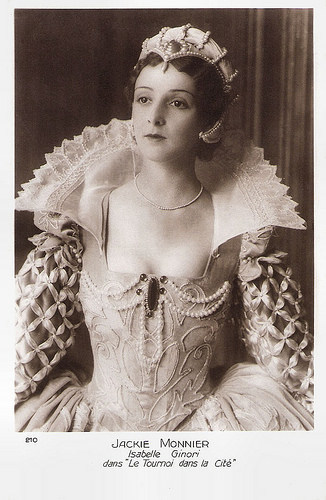
French postcard by Cinémagazine-Edition, no. 210. Photo: publicity still for Le tournoi dans la cité/The Tournament (Jean Renoir, 1928), with Jackie Monnier as Isabelle Ginori.
The winner of the tournament will be Isabelle's husband
The story of Le tournoi dans la cité takes place in 16th Century France, during the reign of the young King Charles IX (Gérard Mock) and his mother Catherine de Medici (Blanche Bernis).
The beautiful Isabelle Ginori (Jackie Monnier) becomes engaged to a Catholic gentleman, Henri de Rogier (Enrique Rivero). Unfortunately, the cruel Protestant leader De Baynes (Aldo Nadi) meets Isabelle and declares in lively terms that she will belong to him.
Count Ginori (Manuel Raabi), the girl's relative, declines the proposal, so François kills him in a duel. For political reasons, the Queen is ready to unite Isabelle and François, but a mistress of the latter, Lucrezia Pazzi (Viviane Clarens), intervenes.
Catherine decides that the winner of the tournament will become Isabelle's husband. François surpasses his rival, but the corpse of Ginori is discovered and the culprit unmasked. Charged by the guard, François succumbs. Isabelle and Henri may finally become engaged.
Who were the actors in this little known film by Jean Renoir? Jackie Monnier would also act in Jean Renoir's final silent film, Le Bled/The Bled (1929). She also appeared in G.W. Pabst's Westfront 1918 (1930) and some 10 other films.
The hero, Chilean actor Enrique Rivero, would become famous for his part in Jean Cocteau's Le sang d'un poète/The Blood of a poet (1930). For a time he was known as the European Rudolph Valentino .
Aldo Nadi was a professional fencer, who had one of his rare film roles here. He also played a bodyguard in the Humphrey Bogart classic To Have and To Have Not (Howard Hawks, 1944).
Little is known about Blanche Bernis, who had a career in late 1920s and 1930s French film. She first played a prostitute in Alberto Cavalcanti's city symphony Rien que les heures (1926).
Her debut was followed by a peak in 1928 films: Cavalcanti's Guy de Maupassant adaptation Yvette (1928) and his En Rade (1928), both starring Catherine Hessling, Renoir's Le tournoi dans la cité (1928), plus Ewald André Dupont's Moulin Rouge (1928), starring Olga Tschechova .
In 1929 she played in L'arpète by Donatien , starring Lucienne Legrand.
In the sound era, Bernis acted in three films: the drama Le train des suicidés (Edmond T. Gréville, 1931), Judex 34 (Maurice Champreux, 1934), and Gosse de Riche (Maurice de Canonge, 1938), starring Madeleine Robinson and Pierre Brasseur .
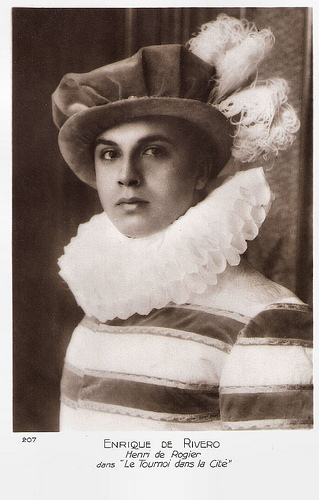
French postcard by Cinémagazine-Edition, no. 207. Photo: publicity still for Le tournoi dans la cité/The Tournament (Jean Renoir, 1928), with Enrique (de) Rivero as Henri de Rogier.
The European Valentino
Le tournoi dans la cité/The Tournament (Jean Renoir, 1928) was commissioned by Société des Films Historiques, a historical society to commemorate 500 years of history of the medieval French city of Carcassonne, where the film was made.
According to D.B. DuMonteil at IMDb , director Jean Renoir did not take the consignment seriously: "It's the (modest) granddaddy of La Reine Margot and other costume dramas in the catholic vs protestants background. It seems that the director had a comfortable budget at his disposal, but it's far from being more than a footnote in his oeuvre."
While the first night of Le tournoi dans la cité/The Tournament (1928) took place in Brussels in December 1928, the Parisian premiere was on 9 February 1929 at the cinema Marivaux.
For many years this silent Renoir was considered lost, except for an abbreviated 40-minute print that could only have provided a tantalising hint of the splendour of the original feature.
Michael Neumann at IMDb calls the restored film 'a handsome medieval romance': "Agile camera-work and painterly lighting effects lend momentum to a drama which otherwise has a tendency to become bogged down in narrative exposition and meticulous period detail, up until the stirring climactic joust."
And the anonymous author at BAMPFA adds: "Although Renoir confessed an aversion to the 'pageantry' genre, he took the opportunity to invent some bravura camera strokes (including at least one magnificently conceived tracking shot) and invested the film with an impressive realism of place (shooting the exteriors in Carcassone), historical detail, and psychology. The highlight of the film is its beautifully staged tournaments and jousts, for which Renoir employed the members of the famous riding school in Samour."
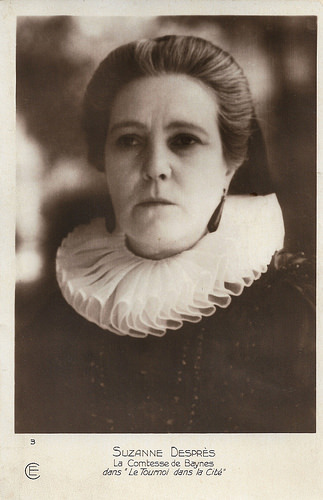
French postcard by Cinémagazine-Edition, no. 3. Photo: publicity still for Le tournoi dans la cité/The Tournament (Jean Renoir, 1928), with Suzanne Desprès as La Comtesse de Baynes.
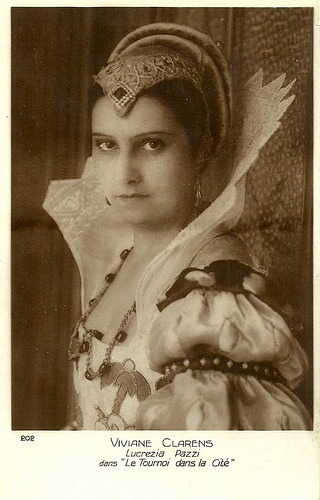
French postcard by Cinémagazine-Edition, no. 202. Photo: publicity still for Le tournoi dans la cité/The Tournament (Jean Renoir, 1928), with Viviane Clarens as Lucrezia Pazzi.
Sources: Michael Neumann (IMDb), D.B. DuMonteil (IMDb), BAMPFA, Wikipedia and IMDb.

French postcard by Cinémagazine-Edition, no. 208. Photo: publicity still for Le tournoi dans la cité/The Tournament (Jean Renoir, 1928), with Blanche Bernis as Cathérine de Médicis.

French postcard by Cinémagazine-Edition, no. 210. Photo: publicity still for Le tournoi dans la cité/The Tournament (Jean Renoir, 1928), with Jackie Monnier as Isabelle Ginori.
The winner of the tournament will be Isabelle's husband
The story of Le tournoi dans la cité takes place in 16th Century France, during the reign of the young King Charles IX (Gérard Mock) and his mother Catherine de Medici (Blanche Bernis).
The beautiful Isabelle Ginori (Jackie Monnier) becomes engaged to a Catholic gentleman, Henri de Rogier (Enrique Rivero). Unfortunately, the cruel Protestant leader De Baynes (Aldo Nadi) meets Isabelle and declares in lively terms that she will belong to him.
Count Ginori (Manuel Raabi), the girl's relative, declines the proposal, so François kills him in a duel. For political reasons, the Queen is ready to unite Isabelle and François, but a mistress of the latter, Lucrezia Pazzi (Viviane Clarens), intervenes.
Catherine decides that the winner of the tournament will become Isabelle's husband. François surpasses his rival, but the corpse of Ginori is discovered and the culprit unmasked. Charged by the guard, François succumbs. Isabelle and Henri may finally become engaged.
Who were the actors in this little known film by Jean Renoir? Jackie Monnier would also act in Jean Renoir's final silent film, Le Bled/The Bled (1929). She also appeared in G.W. Pabst's Westfront 1918 (1930) and some 10 other films.
The hero, Chilean actor Enrique Rivero, would become famous for his part in Jean Cocteau's Le sang d'un poète/The Blood of a poet (1930). For a time he was known as the European Rudolph Valentino .
Aldo Nadi was a professional fencer, who had one of his rare film roles here. He also played a bodyguard in the Humphrey Bogart classic To Have and To Have Not (Howard Hawks, 1944).
Little is known about Blanche Bernis, who had a career in late 1920s and 1930s French film. She first played a prostitute in Alberto Cavalcanti's city symphony Rien que les heures (1926).
Her debut was followed by a peak in 1928 films: Cavalcanti's Guy de Maupassant adaptation Yvette (1928) and his En Rade (1928), both starring Catherine Hessling, Renoir's Le tournoi dans la cité (1928), plus Ewald André Dupont's Moulin Rouge (1928), starring Olga Tschechova .
In 1929 she played in L'arpète by Donatien , starring Lucienne Legrand.
In the sound era, Bernis acted in three films: the drama Le train des suicidés (Edmond T. Gréville, 1931), Judex 34 (Maurice Champreux, 1934), and Gosse de Riche (Maurice de Canonge, 1938), starring Madeleine Robinson and Pierre Brasseur .

French postcard by Cinémagazine-Edition, no. 207. Photo: publicity still for Le tournoi dans la cité/The Tournament (Jean Renoir, 1928), with Enrique (de) Rivero as Henri de Rogier.
The European Valentino
Le tournoi dans la cité/The Tournament (Jean Renoir, 1928) was commissioned by Société des Films Historiques, a historical society to commemorate 500 years of history of the medieval French city of Carcassonne, where the film was made.
According to D.B. DuMonteil at IMDb , director Jean Renoir did not take the consignment seriously: "It's the (modest) granddaddy of La Reine Margot and other costume dramas in the catholic vs protestants background. It seems that the director had a comfortable budget at his disposal, but it's far from being more than a footnote in his oeuvre."
While the first night of Le tournoi dans la cité/The Tournament (1928) took place in Brussels in December 1928, the Parisian premiere was on 9 February 1929 at the cinema Marivaux.
For many years this silent Renoir was considered lost, except for an abbreviated 40-minute print that could only have provided a tantalising hint of the splendour of the original feature.
Michael Neumann at IMDb calls the restored film 'a handsome medieval romance': "Agile camera-work and painterly lighting effects lend momentum to a drama which otherwise has a tendency to become bogged down in narrative exposition and meticulous period detail, up until the stirring climactic joust."
And the anonymous author at BAMPFA adds: "Although Renoir confessed an aversion to the 'pageantry' genre, he took the opportunity to invent some bravura camera strokes (including at least one magnificently conceived tracking shot) and invested the film with an impressive realism of place (shooting the exteriors in Carcassone), historical detail, and psychology. The highlight of the film is its beautifully staged tournaments and jousts, for which Renoir employed the members of the famous riding school in Samour."

French postcard by Cinémagazine-Edition, no. 3. Photo: publicity still for Le tournoi dans la cité/The Tournament (Jean Renoir, 1928), with Suzanne Desprès as La Comtesse de Baynes.

French postcard by Cinémagazine-Edition, no. 202. Photo: publicity still for Le tournoi dans la cité/The Tournament (Jean Renoir, 1928), with Viviane Clarens as Lucrezia Pazzi.
Sources: Michael Neumann (IMDb), D.B. DuMonteil (IMDb), BAMPFA, Wikipedia and IMDb.
Published on August 08, 2018 22:00
August 7, 2018
Grit Hegesa
Grit Hegesa (1891–1972) was a German dancer and silent film actress. She appeared in seventeen films, including Ewald André Dupont's crime film Whitechapel (1920).
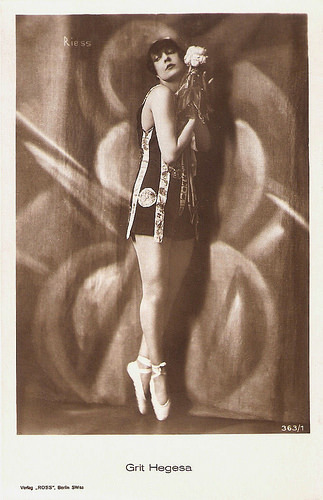
German postcard by Ross Verlag, no. 363/1, 1919-1924. Photo: Frieda Riess.
Wahnsinn
Grit Hegesa was born as Caroline Margaretha Schmidt in Niederlahnstein, German Empire, in 1891.
After attending dance and acting lessons in Brighton in the U.K., she made her first appearances on stage in Germany.
In 1911 Hegesa married businessman Johann Nikolaus Meyer, but they divorced in 1919.
Grit Hegesa made her film debut in Des Prokurators Tochter/The procurator's daughter (William Wauer, 1917) with Adolf Klein and Hermann Thimig .
She became known for such silent films as Hotel Esplanade (Karin Swanström, 1919), the horror film Wahnsinn/Madness (Conrad Veidt, 1919) starring Conrad Veidt , Hegesa and Reinhold Schünzel , and Der weisse Pfau/The White Peacock (Ewald André Dupont, 1920).
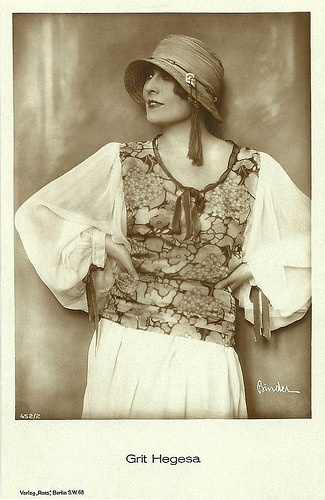
German postcard by Ross Verlag, no. 452/2, 1919-1924. Photo: Alex Binder. Collection: Didier Hanson.
Children of darkness
Grit Hegesa played the leading role in the two-part drama Kinder der Finsternis - 1. Der Mann aus Neapel/Children of darkness - 1. The man from Naples (Ewald André Dupont, 1921) and Kinder der Finsternis - 2. Kämpfende Welte/Children of Darkness - 2. Fighting Worldsn (Ewald André Dupont, 1922) with Hans Mierendorff.
Her final film was Fräulein Else/Miss Else (Paul Czinner, 1929) starring Elisabeth Bergner .
Besides her activity as a film actress, she also acted regularly on stage and performed as a dancer.
Since 1925, Hegesa was married with the artist painter Emil van Hauth. Grit Hegesa died in 1972 in Munich, Germany. She was 80
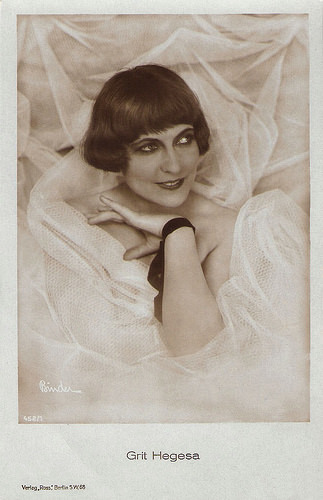
German postcard by Ross Verlag, no. 452/1, 1919-1924. Photo: Alex Binder.
Sources: Wikipedia (German and English) and .

German postcard by Ross Verlag, no. 363/1, 1919-1924. Photo: Frieda Riess.
Wahnsinn
Grit Hegesa was born as Caroline Margaretha Schmidt in Niederlahnstein, German Empire, in 1891.
After attending dance and acting lessons in Brighton in the U.K., she made her first appearances on stage in Germany.
In 1911 Hegesa married businessman Johann Nikolaus Meyer, but they divorced in 1919.
Grit Hegesa made her film debut in Des Prokurators Tochter/The procurator's daughter (William Wauer, 1917) with Adolf Klein and Hermann Thimig .
She became known for such silent films as Hotel Esplanade (Karin Swanström, 1919), the horror film Wahnsinn/Madness (Conrad Veidt, 1919) starring Conrad Veidt , Hegesa and Reinhold Schünzel , and Der weisse Pfau/The White Peacock (Ewald André Dupont, 1920).

German postcard by Ross Verlag, no. 452/2, 1919-1924. Photo: Alex Binder. Collection: Didier Hanson.
Children of darkness
Grit Hegesa played the leading role in the two-part drama Kinder der Finsternis - 1. Der Mann aus Neapel/Children of darkness - 1. The man from Naples (Ewald André Dupont, 1921) and Kinder der Finsternis - 2. Kämpfende Welte/Children of Darkness - 2. Fighting Worldsn (Ewald André Dupont, 1922) with Hans Mierendorff.
Her final film was Fräulein Else/Miss Else (Paul Czinner, 1929) starring Elisabeth Bergner .
Besides her activity as a film actress, she also acted regularly on stage and performed as a dancer.
Since 1925, Hegesa was married with the artist painter Emil van Hauth. Grit Hegesa died in 1972 in Munich, Germany. She was 80

German postcard by Ross Verlag, no. 452/1, 1919-1924. Photo: Alex Binder.
Sources: Wikipedia (German and English) and .
Published on August 07, 2018 22:00
August 6, 2018
New acquisition: postcards of the pre-war Polish cinema
Recently Ivo Blom acquired a series of Polish postcards of Polish films and stars of the late 1920s and early 1930s. We knew very little of this cinema and its stars, although EFSP did some earlier posts on actors like Zbigniew Sawan and a few others. But there are many Polish postcards from this period, often published by the company Polonia in Krakow. For this post we did a bit of research on film stars like Jadwiga Smosarska and Irma Green and we added some postcards to Ivo's from the collections of Joanna and Didier Hanson and from my own collection.

Polish postcard by Polonia, Krakow. Photo: Jadwiga Smosarska in Tredowata/The Leper (Boleslaw Mierzejewski, Edward Puchalski, 1927).
Jadwiga Smosarska (1898-1971) was the biggest star of the Polish cinema of the pre-WW II era. From 1919 on, the Polish actress made more than 25 silent and sound films. She also was very successful on stage. When the Nazis invaded Poland in 1939, she fled to the US. In 1970, she returned to Poland.
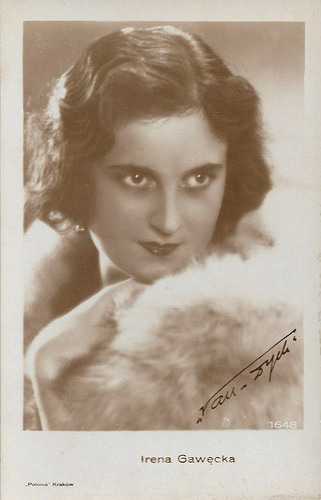
Polish postcard by Polonia, Krakow, no. 1648. Photo: Van Dyck.
Polish actress Irena Gawęcka (1901-1982) was a star of the late silent Polish cinema, who made 5 films between 1928 and 1930.
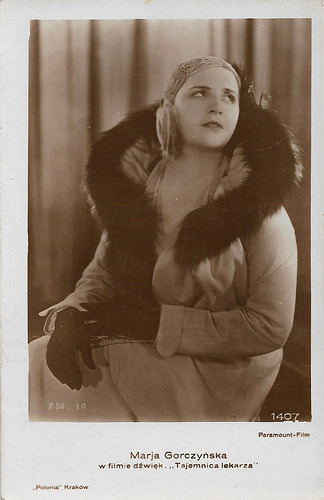
Polish postcard by Polonia, Krakow, no. P. 56-10, 1707. Photo: Paramount-Film.
Marja Gorczynska was the female star of Tajemnica lekarza (Ryszard Ordynski, 1930). The film was shot at the Paramount studios in Joinville near Paris. It was one of the eleven alternative language versions of The Doctor's Secret (William C. de Mille, 1929), based on J.M. Barrie's play Half an Hour, and all shot at Paramount in Paris. In the original American version, Ruth Chatterton had the female lead.
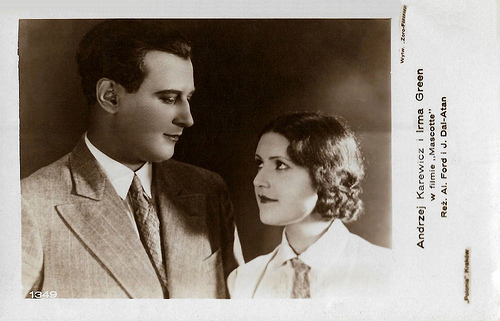
Polish postcard by Polonia, Krakow. Photo: Zoro-Film. Andrzej Karewicz and Irma Green in the film Mascotte (Aleksander Ford, 1930), scripted by Jerzy Dal-Atan.
Mascotte was Aleksander Ford's first feature as director. Ford is better known for his post-war documentary Majdanek - cmentarzysko Europy/Majdanek – the Cemetery of Europe (1945) and the fiction films Ulica Graniczna/Border Street (1949), Piątka z ulicy Barskiej/Five Boys from Barska Street (1954) and Krzyżacy/Knights of the Teutonic Order (1960). Yet, he had already made five feature fiction films and several documentaries and shorts in the 1930s before fleeing to the USSR in the late 1930s when WWII broke out. He returned a convinced and stern communist, became head of the government controlled Film Polski, and was for 20 years professor at the famous Lodz National Film School. During the 1968 Polish crisis, and the raising anti-Jewish sentiments, the Jewish Ford fled the country. Blacklisted and publicly silenced by the communist government and unable to produce successful films abroad, he committed suicide in a Florida hotel in 1980.
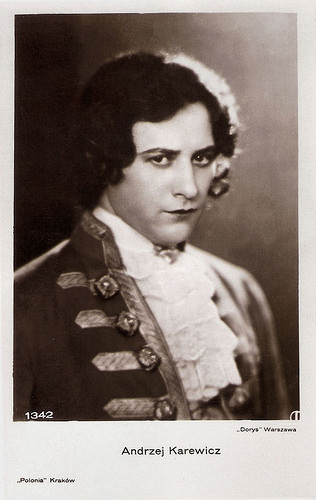
Polish postcard by Polonia, Krakow, no. 1342. Photo: Dorys, Warszawa.
Andrzej Karewicz (1894-1969) was a handsome Polish film actor who appeared in six films in his country between 1928 en 1935. In 1930, he appeared in Aleksander Ford's feature debut Mascotte (1930) with Irma Green.
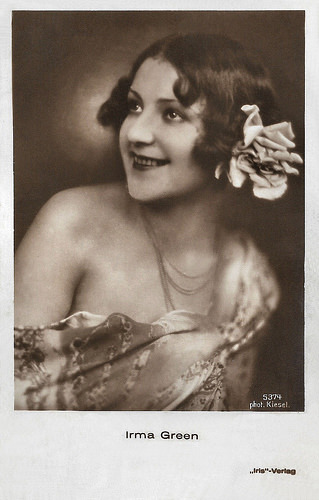
Austrian postcard by Iris-Verlag, no. 5374. Photo: Kiesel.
Polish actress Irma Green (or Gren) appeared in a handful of silent Polish and German films of the laste 1920s.
Living Pictures Theatre
The history of cinema in Poland is almost as long as the history of film. The first cinema in Poland (then occupied by the Russian Empire) was founded in Łódź in 1899, several years after the invention of the Cinematograph. Initially dubbed 'Living Pictures Theatre', it became very popular and by the end of the next decade there were cinemas in almost every major town of Poland.
The earliest surviving feature film, Antoś pierwszy raz w Warszawie/Antoś for the First Time in Warsaw (1908), was directed by and starred Antoni Fertner. The date of its première, 22 October 1908, is considered the founding date of the Polish film industry.
Soon Polish artists started experimenting with other genres of cinema: in 1910 Władysław Starewicz made one of the first animated cartoons in the world - and he was the first to use the stop motion technique, for Piękna Lukanida/Beautiful Lukanida. The Russian revolution forced him to flee to France.
At the end of World War I, when Poland regained independence following over 120 years of occupation, the Polish film industry took off. The large majority of films produced by the burgeoning industry were melodramas and patriotic films.
Polish silent cinema unearthed a major star, who could take advantage of the internationalism afforded by the absence of dialogue. Born Barbara Apolonia Chałupiec, it was as Pola Negri that she shone in first Polish, then German, and finally in American silents films.
Polish cinematography developed dynamically during the inter-war period. Over 150 film studios were set up. Among the most important ones were Sfinks, Leo-Film and Falanga. Their yearly production would amount to 30 features and between 100 and 300 shorts. One of the most important films of the period was Cham/The Boor (Jan Nowina-Przybylski, 1931) with Mieczyslaw Cybulski. The film, an adaptation of Eliza Orzeszkowa's novel, was shown in 13 different countries.
One of the leading figures of the period was director Henryk Szaro, a one-time student of theatre innvovator Vsevolod Meyerhold, and who went on to direct significant films such as Mocny Człowiek/The Strong Man (1929) with Gregori Chmara . Szaro also flourished in the sound era; he made the Faustian drama Pan Twardowski/Mistr Twardowski (1936) and followed it with a Yiddish film, Klamstwo Krystyny/The Vow (1939), on the eve of the war. Szaro, a Polish Jew, was shot dead in 1942 after the Nazis invaded Warsaw.
The chaos and destruction wrought by the second world war meant that Poland had to reinvent its film industry from the ground up after 1945. Ironically, probably the best-known film to survive Poland's pre-war period is the Yiddish musical Yidl mitn fidl/Yidl with a Fiddle (Joseph Green, Jan Nowina-Przybylski, 1936), shot in Krakow's Kazimierz district with an imported American star, Molly Picon.
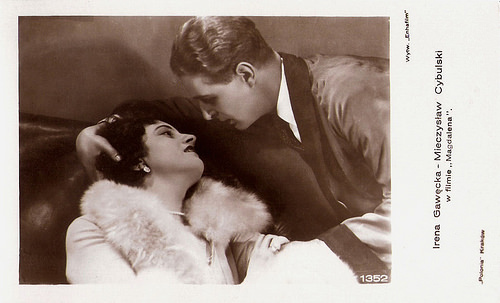
Polish postcard by Polonia, Kraków, no. 1352. Photo: Enhafilm. Publicity still for Magdalena (Konstanty Meglicki, 1929) with Irena Gawecka and Mieczyslaw Cybulski.
Russian-born Mieczyslaw Cybulski (1903-1984) appeared in 26 Polish films between 1927 and 1939. Then the Nazis forced him to fly the country and his film career abruptly ended. He died in Fort Lauderdale, in the U.S., at the age of 81.
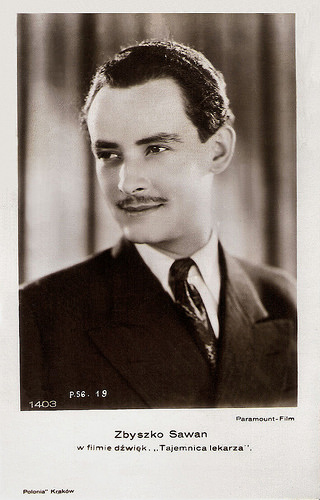
Polish postcard by Polonia, Kraków, no. 1403. Photo: Paramount-Film. Publicity still for Tajemnica Lekarza/The Doctor's Secret (Ryszard Ordynski, 1930).
Polish actor Zbigniew Sawan (1904-1984) starred both in silent and sound film, and was also a respected stage actor in his country. He also worked as a theatre director and manager.
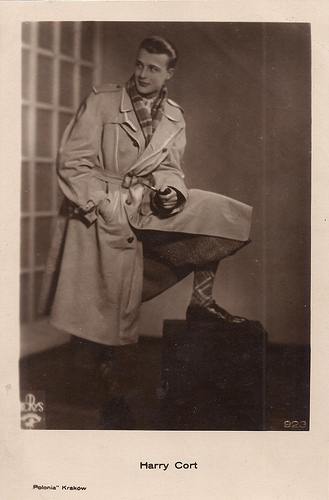
Polish postcard by Polonia, Krakow, no. 923. Collection: Joanna.
Polish actor Harry Cort (1905-?) came from a royal dynasty and had a short film career with starring roles in three silent films, 9:25. Przygoda jednej nocy (1929), Halka (1930) and Karuzela zycia (1930).
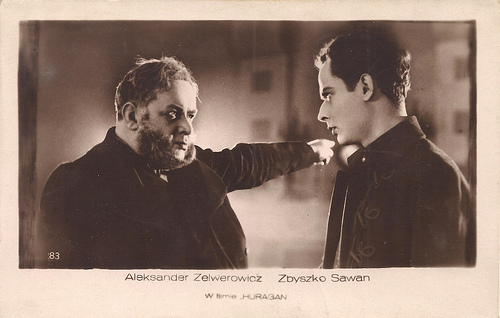
Polish postcard, no. 83. Photo: publicity still for Huragan/Hurricane (Joseph Lejtes, 1928) with Aleksander Zelwerowicz and Zbigniew Sawan . Collection: Joanna.
Aleksander Zelwerowicz (1877-1955) was a Polish actor, director, theatre president and a teacher. He received the Order of Polonia Restituta, one of Poland's highest Orders. He is also one of the Polish Righteous among the Nations, recognized by Yad Vashem as non-Jews who saved Jews from extermination during the Holocaust.
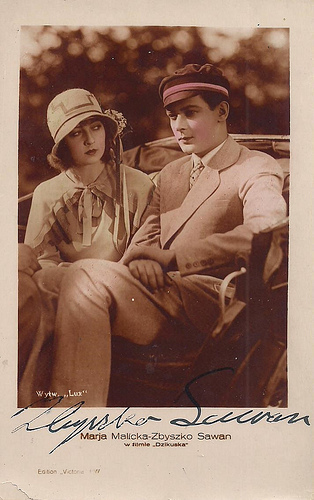
Polish postcard by Edition Victoria. Photo: Lux. Publicity still for Dzikuska/Savage (Henryk Szaro, 1928) with Marja Malicka and Zbigniew Sawan . Collection: Joanna.
Maria Malicka (1900-1992) was married to Zbigniew Sawan and also often his co-star. She starred in 9 Polish film before the Second World War and returned to the screen some 30 years later as a cleaning lady in Jerzy Skolimowski's acclaimed film Bariera/Barrier (1966).
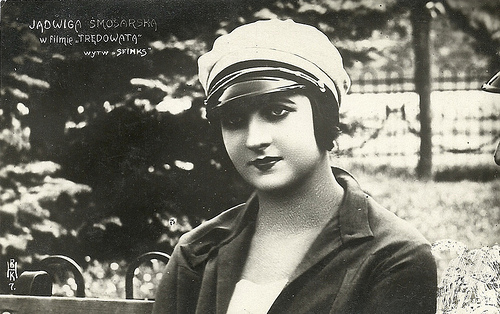
Jadwiga Smosarska. Polish postcard by BHK, no. 7. Photo: Sfinks. Publicity still for Tredowata/The Leper (Boleslaw Mierzejewski, Edward Puchalski, 1927). Collection: Didier Hanson.
Sources: Andrew Pulver (The Guardian), A Foreigner's Guide to Polish Cinema, Wikipedia and IMDb.

Polish postcard by Polonia, Krakow. Photo: Jadwiga Smosarska in Tredowata/The Leper (Boleslaw Mierzejewski, Edward Puchalski, 1927).
Jadwiga Smosarska (1898-1971) was the biggest star of the Polish cinema of the pre-WW II era. From 1919 on, the Polish actress made more than 25 silent and sound films. She also was very successful on stage. When the Nazis invaded Poland in 1939, she fled to the US. In 1970, she returned to Poland.

Polish postcard by Polonia, Krakow, no. 1648. Photo: Van Dyck.
Polish actress Irena Gawęcka (1901-1982) was a star of the late silent Polish cinema, who made 5 films between 1928 and 1930.

Polish postcard by Polonia, Krakow, no. P. 56-10, 1707. Photo: Paramount-Film.
Marja Gorczynska was the female star of Tajemnica lekarza (Ryszard Ordynski, 1930). The film was shot at the Paramount studios in Joinville near Paris. It was one of the eleven alternative language versions of The Doctor's Secret (William C. de Mille, 1929), based on J.M. Barrie's play Half an Hour, and all shot at Paramount in Paris. In the original American version, Ruth Chatterton had the female lead.

Polish postcard by Polonia, Krakow. Photo: Zoro-Film. Andrzej Karewicz and Irma Green in the film Mascotte (Aleksander Ford, 1930), scripted by Jerzy Dal-Atan.
Mascotte was Aleksander Ford's first feature as director. Ford is better known for his post-war documentary Majdanek - cmentarzysko Europy/Majdanek – the Cemetery of Europe (1945) and the fiction films Ulica Graniczna/Border Street (1949), Piątka z ulicy Barskiej/Five Boys from Barska Street (1954) and Krzyżacy/Knights of the Teutonic Order (1960). Yet, he had already made five feature fiction films and several documentaries and shorts in the 1930s before fleeing to the USSR in the late 1930s when WWII broke out. He returned a convinced and stern communist, became head of the government controlled Film Polski, and was for 20 years professor at the famous Lodz National Film School. During the 1968 Polish crisis, and the raising anti-Jewish sentiments, the Jewish Ford fled the country. Blacklisted and publicly silenced by the communist government and unable to produce successful films abroad, he committed suicide in a Florida hotel in 1980.

Polish postcard by Polonia, Krakow, no. 1342. Photo: Dorys, Warszawa.
Andrzej Karewicz (1894-1969) was a handsome Polish film actor who appeared in six films in his country between 1928 en 1935. In 1930, he appeared in Aleksander Ford's feature debut Mascotte (1930) with Irma Green.

Austrian postcard by Iris-Verlag, no. 5374. Photo: Kiesel.
Polish actress Irma Green (or Gren) appeared in a handful of silent Polish and German films of the laste 1920s.
Living Pictures Theatre
The history of cinema in Poland is almost as long as the history of film. The first cinema in Poland (then occupied by the Russian Empire) was founded in Łódź in 1899, several years after the invention of the Cinematograph. Initially dubbed 'Living Pictures Theatre', it became very popular and by the end of the next decade there were cinemas in almost every major town of Poland.
The earliest surviving feature film, Antoś pierwszy raz w Warszawie/Antoś for the First Time in Warsaw (1908), was directed by and starred Antoni Fertner. The date of its première, 22 October 1908, is considered the founding date of the Polish film industry.
Soon Polish artists started experimenting with other genres of cinema: in 1910 Władysław Starewicz made one of the first animated cartoons in the world - and he was the first to use the stop motion technique, for Piękna Lukanida/Beautiful Lukanida. The Russian revolution forced him to flee to France.
At the end of World War I, when Poland regained independence following over 120 years of occupation, the Polish film industry took off. The large majority of films produced by the burgeoning industry were melodramas and patriotic films.
Polish silent cinema unearthed a major star, who could take advantage of the internationalism afforded by the absence of dialogue. Born Barbara Apolonia Chałupiec, it was as Pola Negri that she shone in first Polish, then German, and finally in American silents films.
Polish cinematography developed dynamically during the inter-war period. Over 150 film studios were set up. Among the most important ones were Sfinks, Leo-Film and Falanga. Their yearly production would amount to 30 features and between 100 and 300 shorts. One of the most important films of the period was Cham/The Boor (Jan Nowina-Przybylski, 1931) with Mieczyslaw Cybulski. The film, an adaptation of Eliza Orzeszkowa's novel, was shown in 13 different countries.
One of the leading figures of the period was director Henryk Szaro, a one-time student of theatre innvovator Vsevolod Meyerhold, and who went on to direct significant films such as Mocny Człowiek/The Strong Man (1929) with Gregori Chmara . Szaro also flourished in the sound era; he made the Faustian drama Pan Twardowski/Mistr Twardowski (1936) and followed it with a Yiddish film, Klamstwo Krystyny/The Vow (1939), on the eve of the war. Szaro, a Polish Jew, was shot dead in 1942 after the Nazis invaded Warsaw.
The chaos and destruction wrought by the second world war meant that Poland had to reinvent its film industry from the ground up after 1945. Ironically, probably the best-known film to survive Poland's pre-war period is the Yiddish musical Yidl mitn fidl/Yidl with a Fiddle (Joseph Green, Jan Nowina-Przybylski, 1936), shot in Krakow's Kazimierz district with an imported American star, Molly Picon.

Polish postcard by Polonia, Kraków, no. 1352. Photo: Enhafilm. Publicity still for Magdalena (Konstanty Meglicki, 1929) with Irena Gawecka and Mieczyslaw Cybulski.
Russian-born Mieczyslaw Cybulski (1903-1984) appeared in 26 Polish films between 1927 and 1939. Then the Nazis forced him to fly the country and his film career abruptly ended. He died in Fort Lauderdale, in the U.S., at the age of 81.

Polish postcard by Polonia, Kraków, no. 1403. Photo: Paramount-Film. Publicity still for Tajemnica Lekarza/The Doctor's Secret (Ryszard Ordynski, 1930).
Polish actor Zbigniew Sawan (1904-1984) starred both in silent and sound film, and was also a respected stage actor in his country. He also worked as a theatre director and manager.

Polish postcard by Polonia, Krakow, no. 923. Collection: Joanna.
Polish actor Harry Cort (1905-?) came from a royal dynasty and had a short film career with starring roles in three silent films, 9:25. Przygoda jednej nocy (1929), Halka (1930) and Karuzela zycia (1930).

Polish postcard, no. 83. Photo: publicity still for Huragan/Hurricane (Joseph Lejtes, 1928) with Aleksander Zelwerowicz and Zbigniew Sawan . Collection: Joanna.
Aleksander Zelwerowicz (1877-1955) was a Polish actor, director, theatre president and a teacher. He received the Order of Polonia Restituta, one of Poland's highest Orders. He is also one of the Polish Righteous among the Nations, recognized by Yad Vashem as non-Jews who saved Jews from extermination during the Holocaust.

Polish postcard by Edition Victoria. Photo: Lux. Publicity still for Dzikuska/Savage (Henryk Szaro, 1928) with Marja Malicka and Zbigniew Sawan . Collection: Joanna.
Maria Malicka (1900-1992) was married to Zbigniew Sawan and also often his co-star. She starred in 9 Polish film before the Second World War and returned to the screen some 30 years later as a cleaning lady in Jerzy Skolimowski's acclaimed film Bariera/Barrier (1966).

Jadwiga Smosarska. Polish postcard by BHK, no. 7. Photo: Sfinks. Publicity still for Tredowata/The Leper (Boleslaw Mierzejewski, Edward Puchalski, 1927). Collection: Didier Hanson.
Sources: Andrew Pulver (The Guardian), A Foreigner's Guide to Polish Cinema, Wikipedia and IMDb.
Published on August 06, 2018 22:00
August 5, 2018
Rolf Weih
Rolf Weih (1906–1969) was a German film actor, who played supporting parts in many comedies and musicals of the 1930s and 1940s. After the war he appeared in numerous Heimat-films in West-Germany.

German postcard by Ross Verlag, no. A 2873/1, 1939-1940. Photo: Baumann / Terra.
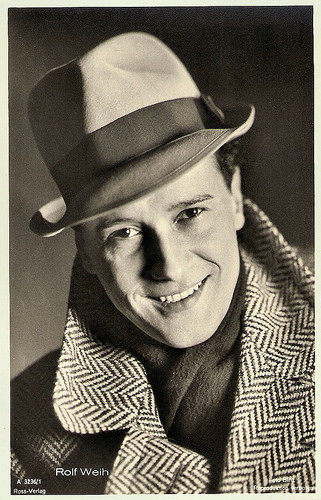
German postcard by Ross Verlag, no. A 3236/1, 1941-1944. Photo: Tita Binz.
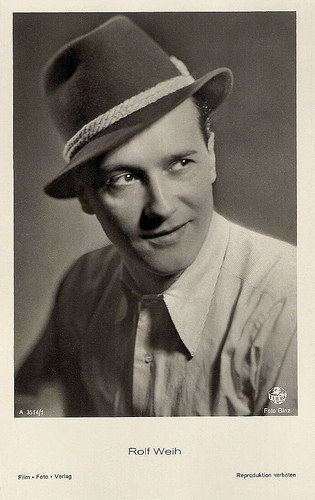
German postcard by Film-Foto-Verlag, no A 3514/1, 1941-1944. Photo: Tita Binz / Terra.
Young lover with a comedic note
Rolf Weih was born in 1906 in Barmen near Wuppertal, Germany. He was the son of a medical board.
After his graduation from high school, Weih did a commercial apprenticeship. He then worked in various industries, including as an engineer at Siemens & Halske in Berlin.
Weih also appeared as an amateur magician at the vaudeville circuit and performed as a cabaret artist. He did performances in Hamburg and Paris. In 1927 he got an engagement at the Rose-Theater in Berlin for three years.
In 1930, he played his first small film role in Flachsmann als Erzieher/Flachsmann as an educator (Carl Heinz Wolff, 1930) with Paul Henckels and Charlotte Ander .
Weih took acting lessons and performed as an operetta buffo in various provincial theatres. In 1936, the Ufa brought him for the film camera for the film Männer vor der Ehe/Men before marriage (Carl Boese, 1936). From then on, Weih worked mainly as a film actor.
He had a supporting part in the Propaganda film Kameraden auf See/Comrades at Sea (Heinz Paul, 1938), starring Theodor Loos . The film is set during the Spanish Civil War, which it portrays as a Communist uprising against the lawful government.
Weih appeared often as the young lover with a comedic note, for example, in Der Gouverneur/The Governor (Viktor Tourjansky, 1939) as the partner of Hannelore Schroth . In Lauter Liebe/Nothing but Love (Heinz Rühmann, 1940), he had one of his few leading roles opposite Hertha Feiler and also did a singing number.
He also appeared in the Revue film Wir machen Musik/We Make Music (Helmut Käutner, 1942), starring Ilse Werner and Viktor de Kowa , and the comedy Meine Frau Teresa/My Wife Theresa (Arthur Maria Rabenalt, 1942) starring Elfie Mayerhofer and Hans Söhnker .
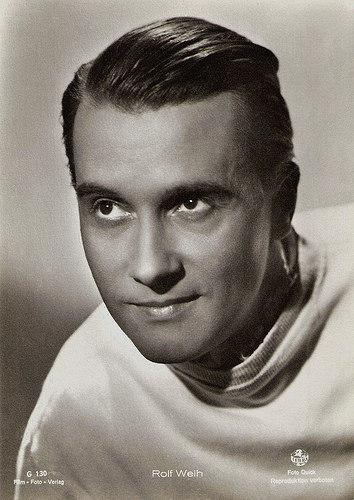
German postcard by Film-Foto-Verlag, no. G 130, 1941-1944. Photo: Terra / Quick.
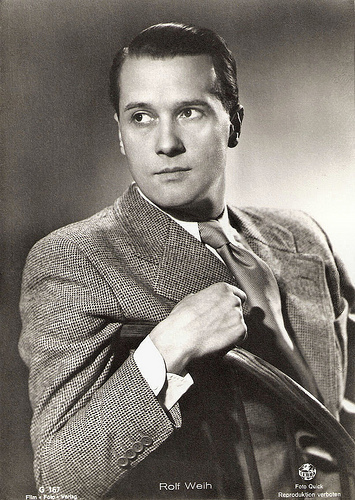
German postcard by Film-Foto-Verlag, no. G 167, 1941-1944. Photo: Terra / Quick.
Diabolical Dr. Mabuse
After the war, Rolf Weih was seen in the West-German crime comedy Freitag, der 13/Friday the Thirteenth (Erich Engels, 19489), starring Fritz Kampers, Angelika Hauff and Fita Benkhoff .
It was already made in 1944 by Tobis, but the film was not released before the end of the Second World War. Several Nazi-era productions were given releases in the years after the end of the war.
Weih also had a supporting part in the crime film Mordprozeß Dr. Jordan/The Murder Trial of Doctor Jordan (Erich Engels, 1949), starring Rudolf Fernau and Maria Holst .
During the 1950s, he became a busy supporting actor and participated in numerous Heimat-films. Examples are Grün ist die Heide/The Heath Is Green (Hans Deppe, 1951) with Sonja Ziemann and Rudolf Prack , and Durch die Wälder, durch die Auen/Through the Forests and Through the Trees (Georg Wilhelm Pabst, 1956) with Eva Bartok .
In East-Germany he appeared in the musical Rauschende Melodien/Swelling Melodies (E.W. Fiedler, 1955), based on the operetta Die Fledermaus (The Bat) by Johann Strauss II and Richard Genée and produced by the state-backed DEFA studios.
Among his final films were Die 1000 Augen des Dr. Mabuse/Diabolical Dr. Mabuse (Fritz Lang, 1960) with Dawn Addams , and the Freddy Quinn musicals Freddy und die Melodie der Nacht/Freddy and the Melody of the Night (Wolfgang Schleif, 1960) and Freddy und das Lied der Südsee/Freddy and the Song of the South Seas (Werner Jacobs, 1962).
For health reasons, he had to restrict his professional activity from 1961 on. Rolf Weih was married to the dancer Ira Kraut and was the father of two children.
In 1969, Rolf Weih died after a heart attack in Frankfurt am Main and was buried in the Berlin cemetery Wilmersdorf. He was 63.
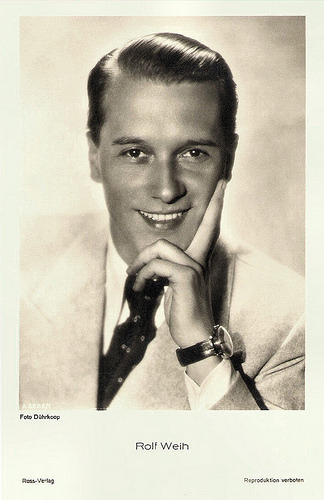
German postcard by Ross-Verlag, no. A 3586/1, 1941-1944. Photo: Dührkoop.
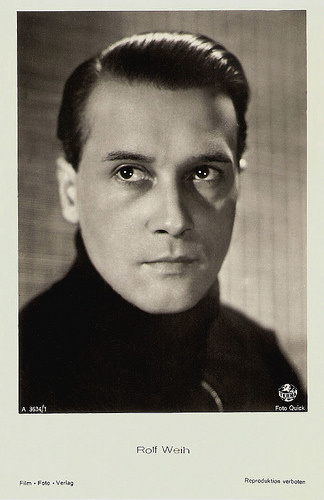
German postcard by Film-Foto-Verlag, no. A 3634/1, 1941-1944. Photo: Terra / Quick.
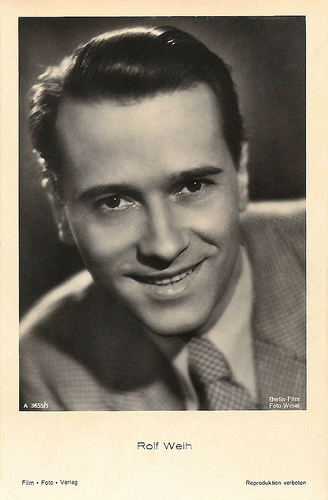
German postcard by Film-Foto-Verlag, no. A 3655/1, 1941-1944. Photo: Wesel / Berlin Film.
Sources: Stephanie D’heil (Steffi-Line – German), Wikipedia (English and German), and .

German postcard by Ross Verlag, no. A 2873/1, 1939-1940. Photo: Baumann / Terra.

German postcard by Ross Verlag, no. A 3236/1, 1941-1944. Photo: Tita Binz.

German postcard by Film-Foto-Verlag, no A 3514/1, 1941-1944. Photo: Tita Binz / Terra.
Young lover with a comedic note
Rolf Weih was born in 1906 in Barmen near Wuppertal, Germany. He was the son of a medical board.
After his graduation from high school, Weih did a commercial apprenticeship. He then worked in various industries, including as an engineer at Siemens & Halske in Berlin.
Weih also appeared as an amateur magician at the vaudeville circuit and performed as a cabaret artist. He did performances in Hamburg and Paris. In 1927 he got an engagement at the Rose-Theater in Berlin for three years.
In 1930, he played his first small film role in Flachsmann als Erzieher/Flachsmann as an educator (Carl Heinz Wolff, 1930) with Paul Henckels and Charlotte Ander .
Weih took acting lessons and performed as an operetta buffo in various provincial theatres. In 1936, the Ufa brought him for the film camera for the film Männer vor der Ehe/Men before marriage (Carl Boese, 1936). From then on, Weih worked mainly as a film actor.
He had a supporting part in the Propaganda film Kameraden auf See/Comrades at Sea (Heinz Paul, 1938), starring Theodor Loos . The film is set during the Spanish Civil War, which it portrays as a Communist uprising against the lawful government.
Weih appeared often as the young lover with a comedic note, for example, in Der Gouverneur/The Governor (Viktor Tourjansky, 1939) as the partner of Hannelore Schroth . In Lauter Liebe/Nothing but Love (Heinz Rühmann, 1940), he had one of his few leading roles opposite Hertha Feiler and also did a singing number.
He also appeared in the Revue film Wir machen Musik/We Make Music (Helmut Käutner, 1942), starring Ilse Werner and Viktor de Kowa , and the comedy Meine Frau Teresa/My Wife Theresa (Arthur Maria Rabenalt, 1942) starring Elfie Mayerhofer and Hans Söhnker .

German postcard by Film-Foto-Verlag, no. G 130, 1941-1944. Photo: Terra / Quick.

German postcard by Film-Foto-Verlag, no. G 167, 1941-1944. Photo: Terra / Quick.
Diabolical Dr. Mabuse
After the war, Rolf Weih was seen in the West-German crime comedy Freitag, der 13/Friday the Thirteenth (Erich Engels, 19489), starring Fritz Kampers, Angelika Hauff and Fita Benkhoff .
It was already made in 1944 by Tobis, but the film was not released before the end of the Second World War. Several Nazi-era productions were given releases in the years after the end of the war.
Weih also had a supporting part in the crime film Mordprozeß Dr. Jordan/The Murder Trial of Doctor Jordan (Erich Engels, 1949), starring Rudolf Fernau and Maria Holst .
During the 1950s, he became a busy supporting actor and participated in numerous Heimat-films. Examples are Grün ist die Heide/The Heath Is Green (Hans Deppe, 1951) with Sonja Ziemann and Rudolf Prack , and Durch die Wälder, durch die Auen/Through the Forests and Through the Trees (Georg Wilhelm Pabst, 1956) with Eva Bartok .
In East-Germany he appeared in the musical Rauschende Melodien/Swelling Melodies (E.W. Fiedler, 1955), based on the operetta Die Fledermaus (The Bat) by Johann Strauss II and Richard Genée and produced by the state-backed DEFA studios.
Among his final films were Die 1000 Augen des Dr. Mabuse/Diabolical Dr. Mabuse (Fritz Lang, 1960) with Dawn Addams , and the Freddy Quinn musicals Freddy und die Melodie der Nacht/Freddy and the Melody of the Night (Wolfgang Schleif, 1960) and Freddy und das Lied der Südsee/Freddy and the Song of the South Seas (Werner Jacobs, 1962).
For health reasons, he had to restrict his professional activity from 1961 on. Rolf Weih was married to the dancer Ira Kraut and was the father of two children.
In 1969, Rolf Weih died after a heart attack in Frankfurt am Main and was buried in the Berlin cemetery Wilmersdorf. He was 63.

German postcard by Ross-Verlag, no. A 3586/1, 1941-1944. Photo: Dührkoop.

German postcard by Film-Foto-Verlag, no. A 3634/1, 1941-1944. Photo: Terra / Quick.

German postcard by Film-Foto-Verlag, no. A 3655/1, 1941-1944. Photo: Wesel / Berlin Film.
Sources: Stephanie D’heil (Steffi-Line – German), Wikipedia (English and German), and .
Published on August 05, 2018 22:00
August 4, 2018
Yoko Tani
Porcelain pretty Yoko Tani (1928–1999) was a French-born Japanese actress and a sensual nightclub entertainer too. She appeared in many French films, but also played starring roles in Japanese, British, American, Canadian and even East-German productions.
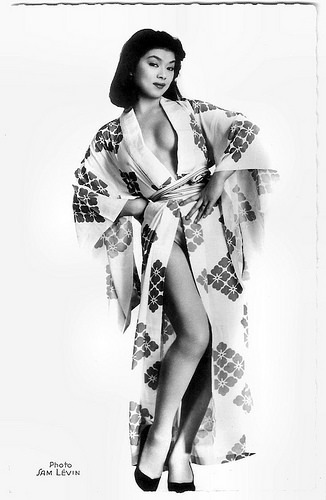
French postcard by Editions du Globe (E.D.U.G.), Paris, no. 469. Photo: Sam Lévin.
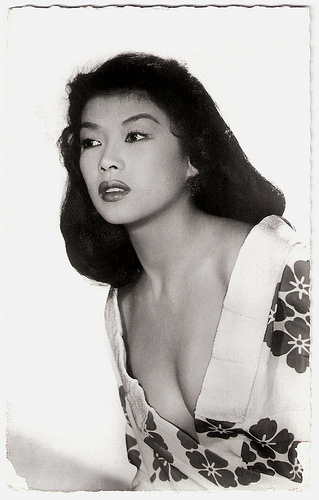
French postcard by Editions du Globe (E.D.U.G.), Paris, no. 713. Photo: Sam Lévin.
Sexy ‘Geisha’ Dances
Yoko Tani was born as Itani Yōko (猪谷洋子) in Paris, France in 1928. She was the daughter of the Japanese ambassador in France and she had a younger sister, Aiko.
She has occasionally been described as 'Eurasian', 'half-French', 'half-Japanese', and even 'Italian-Japanese'. Wikipedia claims that all these descriptions are incorrect: "According to contemporary French sources, her father and mother were attached to the Japanese embassy in Paris, and Tani herself was conceived en route during a shipboard passage from Japan to Europe in 1927, hence given the name Yōko, one reading of which can mean ‘ocean-child.’
Japanese sources indicate that the family returned to Japan in 1930, when Yoko still was a toddler, and she did not return to France until 1950, when her schooling was completed". The Wikipedia author doubts this while there were severe restrictions on Japanese travelling outside Japan directly after WW II. However, the Japanese sources state that Itani had attended an elite Catholic girls' school in Tokyo, and through it secured a Catholic scholarship to study at the University of Paris.
Installing herself in Montmartre, she developed an immediate attraction to cabarets, nightclubs, and music-halls. Setting herself up as an exotic oriental beauty she quickly established a reputation for her provocatively sexy ‘geisha’ dances, which generally ended with her slipping out of her kimono.
It was here she was spotted by famous director Marcel Carné, who took her into his circle of artistic friends, including French actor Roland Lesaffre, whom she would marry in 1956.
As a result, she began to get bit parts in films - starting as a Japanese dancer, in Le port du désir/House on the Waterfront (Edmond T. Gréville, 1954) starring Jean Gabin - and on the stage, with a role as the blue lotus in la Petite Maison de Thé (a French adaptation of The Teahouse of the August Moon) at the Théâtre Montparnasse.
Other films in which she had small roles that year were the crime drama Les Clandestines/Vice Dolls (Raoul André, 1954) with Philippe Lemaire , the Fernandel comedy Ali Baba et les Quarante voleurs/Ali Baba and the Forty Thieves (Jacques Becker, 1954), Marchandes d'illusions/Nights of Shame (Raoul André, 1954) with Nicole Courcel , the crime film Les pépées font la loi/The Chicks Make the law (Raoul André, 1954) with Dominique Wilms , and the German production Verrat an Deutschland/Betrayal of Germany (Veit Harlan, 1954) starring Kristina Söderbaum .

French postcard by Editions du Globe (E.D.U.G.), Paris, no. 787. Photo: Studio Vauclair.
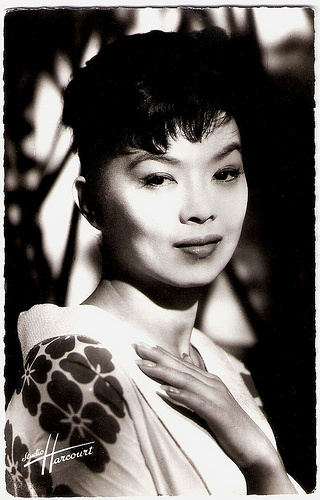
French postcard by Editions du Globe (E.D.U.G.), Paris, no. 800. Photo: Studio Harcourt.
Absolutely Beguiling
Yoko Tani's involvement with cinema was, up to the mid 1950s, limited entirely to that of portraying stereotyped Orientals in French films.
With the end of the US occupation of Japan in 1952, however, postwar Japanese cinema itself burst upon the French scene, culminating in the years 1955 and 1956 when a total of six Japanese films, including Ikimono no Kiroku/I Live in Fear (Akira Kurosawa, 1955), were entered at the Cannes film festival.
At Cannes, Tani made contact with directors Akira Kurosawa and Hisamatsu Seiji, which led to a trip to Japan in 1956 by Tani and Lesaffre, and their joint appearance in the Toho production Fukuaki no seishun/Barefoot Youth (Taniguchi Senkichi, 1956). It was originally intended that the film would be directed by Kurosawa himself, but in the end it fell to his Toho colleague Taniguchi Senkichi. Tani and Lesaffre's ambition was to bring the film back to France and release it in the French market, an aim which was never achieved.
During the same trip, and also for Toho, Tani took a small role in Jōshû to tomo ni/Women in Prison (Hisamatsu Seiji, 1956), in which she played a westernised Japanese Catholic named Mary. This film, now virtually unobtainable, starred the legendary Japanese stars Hara Setsuko and Tanaka Kinuyo.
Early in 1957 Tani appeared in a small role in her first English-language film: the MGM production of Graham Greene's The Quiet American (Joseph L. Mankiewicz, 1957), a political drama set in French Indochina starring Audie Murphy and Michael Redgrave . The American production was shot entirely in Rome with additional location scenes of Saigon. Tani played a francophone Vietnamese nightclub hostess.
She had her breakthrough in English-language cinema came with the war-time love story The Wind Cannot Read (Ralph Thomas, 1959). Gary Brumburgh at IMDb notes about her performance: “The cameras displayed a lovely, quiet beauty in the 1950's and she was absolutely beguiling”. The film had originally been a project of the British producer Alexander Korda, and was to have been directed by David Lean, who in 1955 travelled to Japan with author Richard Mason and cast Japanese actress Kishi Keiko as the female lead. At a very advanced stage, the project fell apart, and a few months later Korda died.
The pieces were eventually picked up by the Rank Organisation, and it was decided to produce the film using the script and locations already set out by Lean, with one of Rank's big stars, Dirk Bogarde , in the male lead as a British POW in a Japanese camp. Tani played his ill wife.
The film was a modest commercial success, and lead to further roles in British co-productions - as the Inuit Asiak in the Anglo-French-Italian The Savage Innocents (Nicholas Ray, 1959) with Anthony Quinn , and as the ingenue Seraphina in the crime drama Piccadilly Third Stop (Wolf Rilla, 1960).
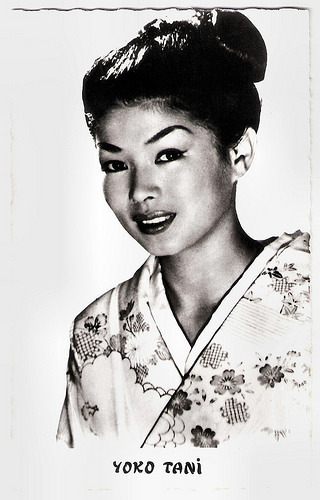
Vintage card, no. 914.
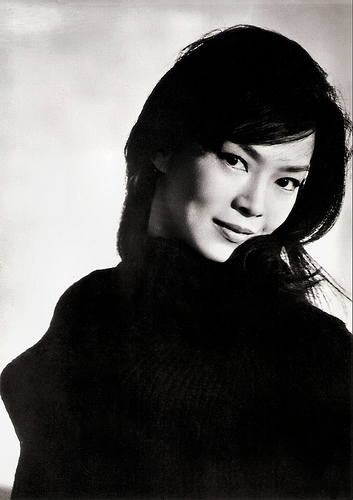
Italian postcard by Alterocca, Terni, no. 49142.
Meek Princess in Distress
Aside from The Quiet American, Yoko Tani’s only other Hollywood roles were in the comedy My Geisha (Jack Cardiff, 1962) starring Shirley MacLaine and Yves Montand - shot, however, on location in Japan - and the lively sex-comedy Who's Been Sleeping in My Bed? (Daniel Mann, 1963) with Dean Martin as a womanising soap-opera star.
Usually type-cast as an exotic, Tani nevertheless got to play unusual roles as a result. She portrayed Japanese medical doctor Sumiko Ogimura in one of the few Communist-bloc Sci-Fi films, the East-German/Polish film adaptation of Stanisław Lem's novel The Astronauts, Der schweigende Stern/Milcząca Gwiazda/First Spaceship on Venus (Kurt Maetzig, Hieronim Przybył, 1959).
Perhaps even more unusual (for the time) was her trip to the Vancouver Islands in Canada to play the role of Mary Ota in The Sweet and the Bitter (James Clavell, 1962-1967), which treated the aftermath of the wartime internment of Canadian Japanese and the loss of their properties and their businesses.
In Italy she became a customary player of meek princess-in-distress types in such Peplums as Maciste alla corte del Gran Khan/Maciste at the Court of the Great Khan (Riccardo Freda, 1961) starring muscleman Gordon Scott , and Ursus e la ragazza tartara/The Tartar Invasion (Remigio Del Grosso, 1961), which co-starred her husband, Roland Lesaffre.
In 1962, she returned to France. Her marriage to Lesaffre, who maintained an ongoing, homosexual liaison with Marcel Carné, was childless. It ended in divorce in 1962.
From this point on, she was to be more strictly Europe-based and to take on work mainly as a femme fatale in Eurospy films as OSS 77 – Operazione fior di loto/OSS77 – Operation Lotus (Bruno Paolinelli, 1967) with Dominique Boschero , and in the final two episodes of the popular British TV series Danger Man/Secret Agent, featuring Patrick McGoohan . These episodes – filmed in colour - were combined into one feature-length film, Koroshi (Michael Truman, Peter Yates, 1967) that was released theatrically in several countries.
Despite her involvement with film, Tani never abandoned her attachment to nightclub and cabaret. She worked as a stripper in the well-known Le Crazy Horse de Paris and other girlie clubs. Even as late as 1977, she had a small role in the Brazilian sexploitation thriller O Estripador de Mulheres/The Women Ripper (Juan Bajon, 1977). That year she also starred in a transvestite show in downtown São Paulo.
Her final film was the French comedy Ça fait tilt!/Tilt (André Hunebelle, 1978) with Bernard Menez and Eleonora Giorgi. On TV her final appearance was as a madam in the erotic anthology Serie rose/Softly from Paris (Walerian Borowczyk, 1986).
In later life Tani remarried, wedding Roger Laforet, a native of the seaside village of Binic in Brittany. A wealthy industrialist, Laforet was an associate of Baron Marcel Bich, co-founder of the BIC consumer products empire. Tani's declining years were spent between Paris and their house in Paimpol overlooking the sea. Gary Brumburgh adds at IMDb : “In later years she enjoyed painting and was devoted to her religion and her dog that she named ‘Toto’.”
Yoko Tani died of cancer in 1999 in Paris, after a long illness. She is buried in Binic, together with Laforet. Their tomb carries the Breton inscription «Ganeoc'h Bepred» (roughly, "Always With You"). Her late husband, Ronald Lesaffre, is buried together with Marcel Carné in his grave in the Cimetière Saint-Vincent in Montmartre.
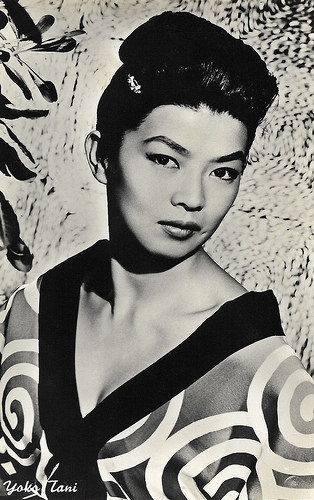
Italian postcard by Bromofoto, Milano, no. 1391. Sadly the edges above and at right of the card were cut off by a former owner.
German trailer of Der schweigende Stern/Milcząca Gwiazda/First Spaceship on Venus (1959). Source: DEFA Stiftung (YouTube).
Source: (IMDb), Hal Erickson (AllMovie), Wikipedia and .

French postcard by Editions du Globe (E.D.U.G.), Paris, no. 469. Photo: Sam Lévin.

French postcard by Editions du Globe (E.D.U.G.), Paris, no. 713. Photo: Sam Lévin.
Sexy ‘Geisha’ Dances
Yoko Tani was born as Itani Yōko (猪谷洋子) in Paris, France in 1928. She was the daughter of the Japanese ambassador in France and she had a younger sister, Aiko.
She has occasionally been described as 'Eurasian', 'half-French', 'half-Japanese', and even 'Italian-Japanese'. Wikipedia claims that all these descriptions are incorrect: "According to contemporary French sources, her father and mother were attached to the Japanese embassy in Paris, and Tani herself was conceived en route during a shipboard passage from Japan to Europe in 1927, hence given the name Yōko, one reading of which can mean ‘ocean-child.’
Japanese sources indicate that the family returned to Japan in 1930, when Yoko still was a toddler, and she did not return to France until 1950, when her schooling was completed". The Wikipedia author doubts this while there were severe restrictions on Japanese travelling outside Japan directly after WW II. However, the Japanese sources state that Itani had attended an elite Catholic girls' school in Tokyo, and through it secured a Catholic scholarship to study at the University of Paris.
Installing herself in Montmartre, she developed an immediate attraction to cabarets, nightclubs, and music-halls. Setting herself up as an exotic oriental beauty she quickly established a reputation for her provocatively sexy ‘geisha’ dances, which generally ended with her slipping out of her kimono.
It was here she was spotted by famous director Marcel Carné, who took her into his circle of artistic friends, including French actor Roland Lesaffre, whom she would marry in 1956.
As a result, she began to get bit parts in films - starting as a Japanese dancer, in Le port du désir/House on the Waterfront (Edmond T. Gréville, 1954) starring Jean Gabin - and on the stage, with a role as the blue lotus in la Petite Maison de Thé (a French adaptation of The Teahouse of the August Moon) at the Théâtre Montparnasse.
Other films in which she had small roles that year were the crime drama Les Clandestines/Vice Dolls (Raoul André, 1954) with Philippe Lemaire , the Fernandel comedy Ali Baba et les Quarante voleurs/Ali Baba and the Forty Thieves (Jacques Becker, 1954), Marchandes d'illusions/Nights of Shame (Raoul André, 1954) with Nicole Courcel , the crime film Les pépées font la loi/The Chicks Make the law (Raoul André, 1954) with Dominique Wilms , and the German production Verrat an Deutschland/Betrayal of Germany (Veit Harlan, 1954) starring Kristina Söderbaum .

French postcard by Editions du Globe (E.D.U.G.), Paris, no. 787. Photo: Studio Vauclair.

French postcard by Editions du Globe (E.D.U.G.), Paris, no. 800. Photo: Studio Harcourt.
Absolutely Beguiling
Yoko Tani's involvement with cinema was, up to the mid 1950s, limited entirely to that of portraying stereotyped Orientals in French films.
With the end of the US occupation of Japan in 1952, however, postwar Japanese cinema itself burst upon the French scene, culminating in the years 1955 and 1956 when a total of six Japanese films, including Ikimono no Kiroku/I Live in Fear (Akira Kurosawa, 1955), were entered at the Cannes film festival.
At Cannes, Tani made contact with directors Akira Kurosawa and Hisamatsu Seiji, which led to a trip to Japan in 1956 by Tani and Lesaffre, and their joint appearance in the Toho production Fukuaki no seishun/Barefoot Youth (Taniguchi Senkichi, 1956). It was originally intended that the film would be directed by Kurosawa himself, but in the end it fell to his Toho colleague Taniguchi Senkichi. Tani and Lesaffre's ambition was to bring the film back to France and release it in the French market, an aim which was never achieved.
During the same trip, and also for Toho, Tani took a small role in Jōshû to tomo ni/Women in Prison (Hisamatsu Seiji, 1956), in which she played a westernised Japanese Catholic named Mary. This film, now virtually unobtainable, starred the legendary Japanese stars Hara Setsuko and Tanaka Kinuyo.
Early in 1957 Tani appeared in a small role in her first English-language film: the MGM production of Graham Greene's The Quiet American (Joseph L. Mankiewicz, 1957), a political drama set in French Indochina starring Audie Murphy and Michael Redgrave . The American production was shot entirely in Rome with additional location scenes of Saigon. Tani played a francophone Vietnamese nightclub hostess.
She had her breakthrough in English-language cinema came with the war-time love story The Wind Cannot Read (Ralph Thomas, 1959). Gary Brumburgh at IMDb notes about her performance: “The cameras displayed a lovely, quiet beauty in the 1950's and she was absolutely beguiling”. The film had originally been a project of the British producer Alexander Korda, and was to have been directed by David Lean, who in 1955 travelled to Japan with author Richard Mason and cast Japanese actress Kishi Keiko as the female lead. At a very advanced stage, the project fell apart, and a few months later Korda died.
The pieces were eventually picked up by the Rank Organisation, and it was decided to produce the film using the script and locations already set out by Lean, with one of Rank's big stars, Dirk Bogarde , in the male lead as a British POW in a Japanese camp. Tani played his ill wife.
The film was a modest commercial success, and lead to further roles in British co-productions - as the Inuit Asiak in the Anglo-French-Italian The Savage Innocents (Nicholas Ray, 1959) with Anthony Quinn , and as the ingenue Seraphina in the crime drama Piccadilly Third Stop (Wolf Rilla, 1960).

Vintage card, no. 914.

Italian postcard by Alterocca, Terni, no. 49142.
Meek Princess in Distress
Aside from The Quiet American, Yoko Tani’s only other Hollywood roles were in the comedy My Geisha (Jack Cardiff, 1962) starring Shirley MacLaine and Yves Montand - shot, however, on location in Japan - and the lively sex-comedy Who's Been Sleeping in My Bed? (Daniel Mann, 1963) with Dean Martin as a womanising soap-opera star.
Usually type-cast as an exotic, Tani nevertheless got to play unusual roles as a result. She portrayed Japanese medical doctor Sumiko Ogimura in one of the few Communist-bloc Sci-Fi films, the East-German/Polish film adaptation of Stanisław Lem's novel The Astronauts, Der schweigende Stern/Milcząca Gwiazda/First Spaceship on Venus (Kurt Maetzig, Hieronim Przybył, 1959).
Perhaps even more unusual (for the time) was her trip to the Vancouver Islands in Canada to play the role of Mary Ota in The Sweet and the Bitter (James Clavell, 1962-1967), which treated the aftermath of the wartime internment of Canadian Japanese and the loss of their properties and their businesses.
In Italy she became a customary player of meek princess-in-distress types in such Peplums as Maciste alla corte del Gran Khan/Maciste at the Court of the Great Khan (Riccardo Freda, 1961) starring muscleman Gordon Scott , and Ursus e la ragazza tartara/The Tartar Invasion (Remigio Del Grosso, 1961), which co-starred her husband, Roland Lesaffre.
In 1962, she returned to France. Her marriage to Lesaffre, who maintained an ongoing, homosexual liaison with Marcel Carné, was childless. It ended in divorce in 1962.
From this point on, she was to be more strictly Europe-based and to take on work mainly as a femme fatale in Eurospy films as OSS 77 – Operazione fior di loto/OSS77 – Operation Lotus (Bruno Paolinelli, 1967) with Dominique Boschero , and in the final two episodes of the popular British TV series Danger Man/Secret Agent, featuring Patrick McGoohan . These episodes – filmed in colour - were combined into one feature-length film, Koroshi (Michael Truman, Peter Yates, 1967) that was released theatrically in several countries.
Despite her involvement with film, Tani never abandoned her attachment to nightclub and cabaret. She worked as a stripper in the well-known Le Crazy Horse de Paris and other girlie clubs. Even as late as 1977, she had a small role in the Brazilian sexploitation thriller O Estripador de Mulheres/The Women Ripper (Juan Bajon, 1977). That year she also starred in a transvestite show in downtown São Paulo.
Her final film was the French comedy Ça fait tilt!/Tilt (André Hunebelle, 1978) with Bernard Menez and Eleonora Giorgi. On TV her final appearance was as a madam in the erotic anthology Serie rose/Softly from Paris (Walerian Borowczyk, 1986).
In later life Tani remarried, wedding Roger Laforet, a native of the seaside village of Binic in Brittany. A wealthy industrialist, Laforet was an associate of Baron Marcel Bich, co-founder of the BIC consumer products empire. Tani's declining years were spent between Paris and their house in Paimpol overlooking the sea. Gary Brumburgh adds at IMDb : “In later years she enjoyed painting and was devoted to her religion and her dog that she named ‘Toto’.”
Yoko Tani died of cancer in 1999 in Paris, after a long illness. She is buried in Binic, together with Laforet. Their tomb carries the Breton inscription «Ganeoc'h Bepred» (roughly, "Always With You"). Her late husband, Ronald Lesaffre, is buried together with Marcel Carné in his grave in the Cimetière Saint-Vincent in Montmartre.

Italian postcard by Bromofoto, Milano, no. 1391. Sadly the edges above and at right of the card were cut off by a former owner.
German trailer of Der schweigende Stern/Milcząca Gwiazda/First Spaceship on Venus (1959). Source: DEFA Stiftung (YouTube).
Source: (IMDb), Hal Erickson (AllMovie), Wikipedia and .
Published on August 04, 2018 22:00
August 3, 2018
Photo by Frieda Riess
Lately, there has been a revival of interest in photographer Frieda Riess (1890-ca. 1955), who had a studio in central Berlin. In Germany, a biography was published and in 1908, the Berlinische Galerie had a major exhibition with Riess'portraits. Her sitters included Albert Einstein, Benito Mussolini, Josephine Baker, Jack Dempsey and many film stars. She also worked as the stills photographer on Fritz Lang’s films.
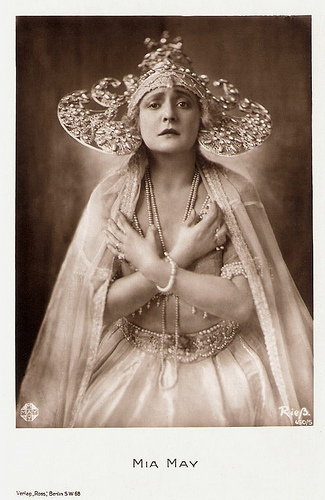
Mia May . German postcard by Ross Verlag, no. 450/5, 1919-1924. Photo: May-Film / Riess. Possibly for Die Herrin der Welt/The Mistress of the World (Joe May a.o., 1919).
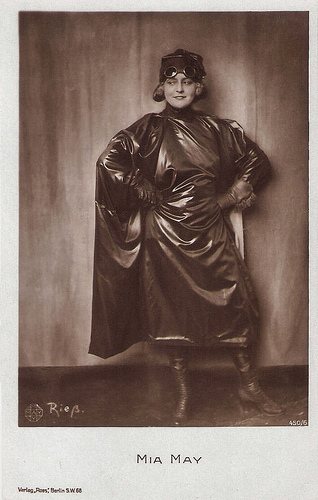
Mia May . German Postcard by Ross Verlag, no. 450/6, 1919-1924. Photo: May Film / Riess. Possibly for Die Herrin der Welt/The Mistress of the World (Joe May a.o., 1919).
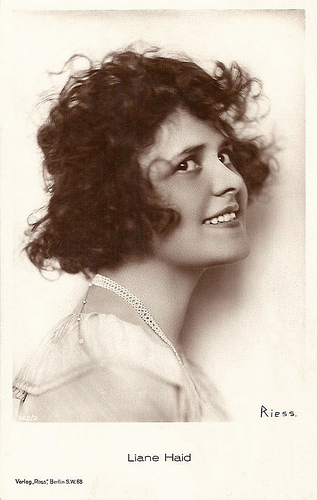
Liane Haid . German postcard by Ross Verlag, Berlin, no. 462/2, 1919-1924. Photo: Riess.
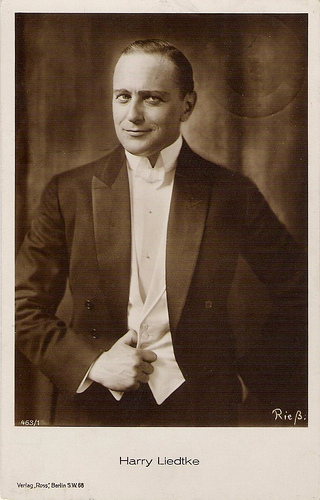
Harry Liedtke . German postcard by Ross Verlag, no. 463/1, 1919-1924. Photo: Riess.
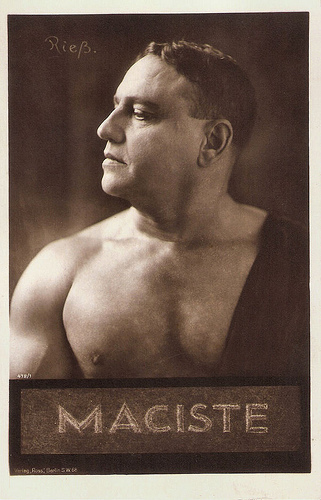
Bartolomeo Pagano aka Maciste. German postcard by Ross Verlag, no. 478/1, 1919-1924. Photo: Riess.
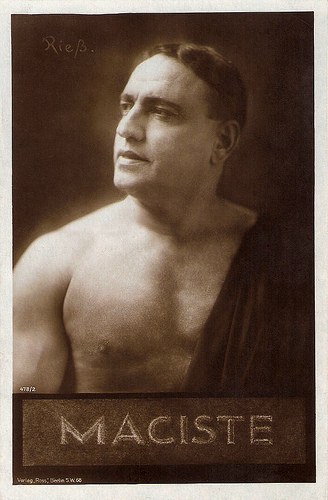
Bartolomeo Pagano aka Maciste. German postcard by Ross Verlag, no. 478/2, 1919-1924. Photo: Riess.
An exclusive meeting place for Berlin celebrities
Frieda Riess was born in Czarnikau in the Western Prussian town of Czarnikau (now Carnkov in Poland) in the province of Poznán where her German-Jewish parents were shopkeepers.
At the end of the 1890s, the family moved to Berlin where she first studied sculpture under Hugo Lederer (c. 1907) and later photography at the Berlin 'Photographischen Lehranstalt' of the Lette Verein (she later inspired photographer Marianne Breslauer to enrol there too). Riess received her diploma in the summer of 1915.
In 1918, she opened a studio (in German: atelier) on the prestigious Kurfürstendamm. It became one of the most popular studios in the city. Partly as a result of her marriage to the poet and journalist Rudolf Leonhard in the early 1920s, her social connections extended through Berlin’s art world of the 1920s. Her studio became an exclusive meeting place at exhibition openings.
Her clientele included such celebrities as playwright Walter Hasenclever, novelist Gerhart Hauptmann and actors and actresses including Tilla Durieux, Asta Nielsen , Mia May and her daughter Eva May , and Emil Jannings . In addition, she contributed to the journals and magazines of the day including Die Dame, Berliner Illustrierte Zeitung, Der Weltspiegel, Querschnit and Koralle.
Like her colleagues Hugo Erfurth, Madame D´Ora, Lotte Jacobi and Edward Steichen, Riess became a master of the advanced art of portraiture. The solo exhibition of 177 portraits in Alfred Flechtheim’s gallery in 1925 played a decisive part in this appreciation of the photographer. Flechtheim was one of the leading collectors and dealers in modern art during the 1920s. At that time it was somewhat surprising for one of Berlin’s leading art dealers to show photographs, and the fact that he refers to photography as art invited particular attention.
Riess travelled to Paris, London and Rome, where she moved in similar literary and aristocratic circles. While on a trip to Italy in 1929, she was invited to photograph Benito Mussolini.
Why she doesn’t rate a mention in histories of German photography until recently? Part of that was through her design. Since 1930 Frieda Riess had a liaison with the elderly French ambassador to Berlin, Pierre de Margerie. In 1932, they married and moved to Paris. She retreated from photography and Berlin society. She disappeared from the public eye.
From 1940 to 1945, she survived the German occupation of Paris in seclusion, and died there in the mid 1950s. The date of her death cannot be clearly established and her place of burial remains unknown.
In 2008, a retrospective of the work of Frieda Riess was held in the Berlinische Galerie. That year Thomas Ehrsam published 'Die Riess: fotografisches Atelier und Salon in Berlin 1918-1932'.
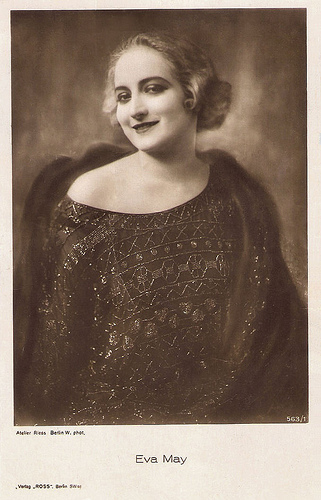
Eva May . German postcard by Ross Verlag, no. 563/1, 1919-1924. Photo: Atelier Riess.
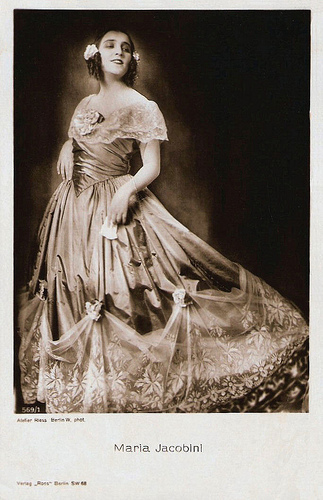
Maria Jacobini . German postcard by Ross Verlag, Berlin, no. 569/1, 1919-1924. Photo: Atelier Riess, Berlin.
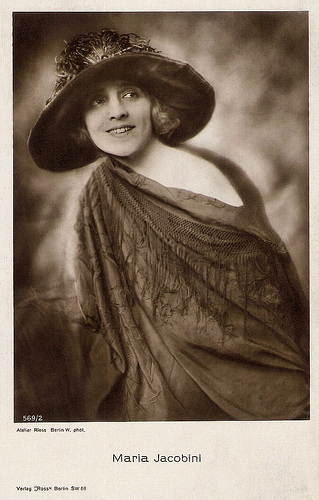
Maria Jacobini . German postcard by Ross Verlag, Berlin, no. 569/2, 1919-1924. Photo: Atelier Riess, Berlin.
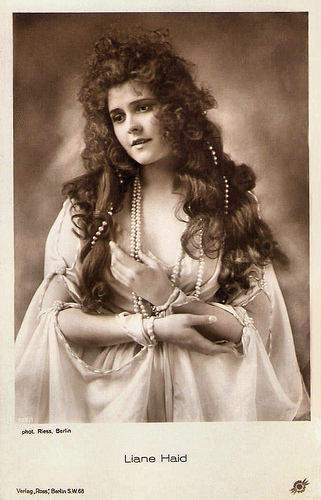
Liane Haid . German postcard by Ross Verlag, no. 1023/1, 1927-1928. Photo: Riess, Berlin.
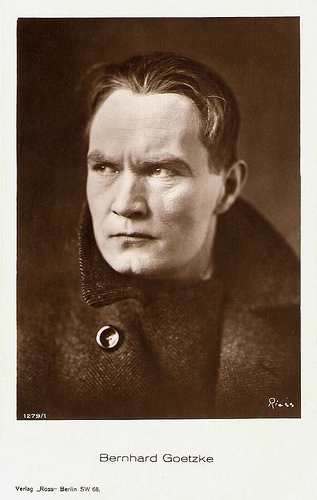
Bernhard Goetzke . German postcard by Ross Verlag, no. 1279/1, 1927-1928. Photo: Riess.
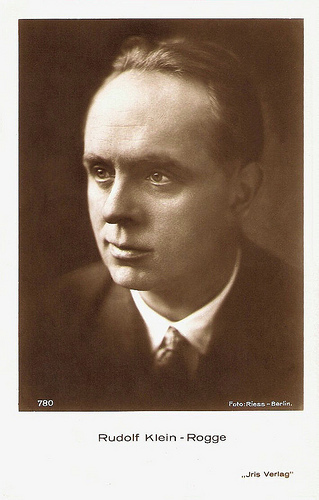
Rudolf Klein-Rogge . Austrian postcard by Iris Verlag no. 780. Photo: Riess, Berlin.
Sources: Kraftgenie (Weimar), One Man's Treasure and Wikipedia.

Mia May . German postcard by Ross Verlag, no. 450/5, 1919-1924. Photo: May-Film / Riess. Possibly for Die Herrin der Welt/The Mistress of the World (Joe May a.o., 1919).

Mia May . German Postcard by Ross Verlag, no. 450/6, 1919-1924. Photo: May Film / Riess. Possibly for Die Herrin der Welt/The Mistress of the World (Joe May a.o., 1919).

Liane Haid . German postcard by Ross Verlag, Berlin, no. 462/2, 1919-1924. Photo: Riess.

Harry Liedtke . German postcard by Ross Verlag, no. 463/1, 1919-1924. Photo: Riess.

Bartolomeo Pagano aka Maciste. German postcard by Ross Verlag, no. 478/1, 1919-1924. Photo: Riess.

Bartolomeo Pagano aka Maciste. German postcard by Ross Verlag, no. 478/2, 1919-1924. Photo: Riess.
An exclusive meeting place for Berlin celebrities
Frieda Riess was born in Czarnikau in the Western Prussian town of Czarnikau (now Carnkov in Poland) in the province of Poznán where her German-Jewish parents were shopkeepers.
At the end of the 1890s, the family moved to Berlin where she first studied sculpture under Hugo Lederer (c. 1907) and later photography at the Berlin 'Photographischen Lehranstalt' of the Lette Verein (she later inspired photographer Marianne Breslauer to enrol there too). Riess received her diploma in the summer of 1915.
In 1918, she opened a studio (in German: atelier) on the prestigious Kurfürstendamm. It became one of the most popular studios in the city. Partly as a result of her marriage to the poet and journalist Rudolf Leonhard in the early 1920s, her social connections extended through Berlin’s art world of the 1920s. Her studio became an exclusive meeting place at exhibition openings.
Her clientele included such celebrities as playwright Walter Hasenclever, novelist Gerhart Hauptmann and actors and actresses including Tilla Durieux, Asta Nielsen , Mia May and her daughter Eva May , and Emil Jannings . In addition, she contributed to the journals and magazines of the day including Die Dame, Berliner Illustrierte Zeitung, Der Weltspiegel, Querschnit and Koralle.
Like her colleagues Hugo Erfurth, Madame D´Ora, Lotte Jacobi and Edward Steichen, Riess became a master of the advanced art of portraiture. The solo exhibition of 177 portraits in Alfred Flechtheim’s gallery in 1925 played a decisive part in this appreciation of the photographer. Flechtheim was one of the leading collectors and dealers in modern art during the 1920s. At that time it was somewhat surprising for one of Berlin’s leading art dealers to show photographs, and the fact that he refers to photography as art invited particular attention.
Riess travelled to Paris, London and Rome, where she moved in similar literary and aristocratic circles. While on a trip to Italy in 1929, she was invited to photograph Benito Mussolini.
Why she doesn’t rate a mention in histories of German photography until recently? Part of that was through her design. Since 1930 Frieda Riess had a liaison with the elderly French ambassador to Berlin, Pierre de Margerie. In 1932, they married and moved to Paris. She retreated from photography and Berlin society. She disappeared from the public eye.
From 1940 to 1945, she survived the German occupation of Paris in seclusion, and died there in the mid 1950s. The date of her death cannot be clearly established and her place of burial remains unknown.
In 2008, a retrospective of the work of Frieda Riess was held in the Berlinische Galerie. That year Thomas Ehrsam published 'Die Riess: fotografisches Atelier und Salon in Berlin 1918-1932'.

Eva May . German postcard by Ross Verlag, no. 563/1, 1919-1924. Photo: Atelier Riess.

Maria Jacobini . German postcard by Ross Verlag, Berlin, no. 569/1, 1919-1924. Photo: Atelier Riess, Berlin.

Maria Jacobini . German postcard by Ross Verlag, Berlin, no. 569/2, 1919-1924. Photo: Atelier Riess, Berlin.

Liane Haid . German postcard by Ross Verlag, no. 1023/1, 1927-1928. Photo: Riess, Berlin.

Bernhard Goetzke . German postcard by Ross Verlag, no. 1279/1, 1927-1928. Photo: Riess.

Rudolf Klein-Rogge . Austrian postcard by Iris Verlag no. 780. Photo: Riess, Berlin.
Sources: Kraftgenie (Weimar), One Man's Treasure and Wikipedia.
Published on August 03, 2018 22:00
August 2, 2018
Sascha Hehn
German actor and he-man Sascha Hehn (1954) participated in many feature films including a dozen sexploitation films. He is best known for two long-running TV shows, but he also acted on stage and dubbed international films. His is the German voice of Shrek in the famous animation films.

German autograph card by Honda. Photo: Gabowicz, München. Publicity still for the TV series Das Traumschiff/The Dreamboat (1981-1991).

German autograph card by Karstadt. Caption: Sascha Hehn trägt Globetrotter von KARSTADT.
Film debut at five
Alexander Josef Alberto ‘Sascha’ Hehn was born in 1954 in Munich. He is one of the four sons of film actor Albert Hehn from his fourth marriage to Gardy Artinger, a former beauty-queen and assistant director.
After the divorce of his parents, he lived with his mother in the Munich suburb of Grünwald. At the age of five he made his film debut in the Heimatfilm Hubertusjagd/Hubertus Castle (Hermann Kugelstadt, 1959) starring Wolf Albach-Retty and Angelika Meissner in her final role.
More film roles for Hehn followed soon. He had parts in the melodrama Ein Student ging vorbei/A student passed by (Werner Klingler, 1960) with Luise Ullrich , and the Schlager and Heimat film Drei weiße Birken/Three White Birches (Hans Albin, 1961), starring Erika Remberg . As a pupil, he was so busy with his acting career that he left school before he reached the middle school.
During the 1960s he could be seen in many TV films, such as Der doppelte Nikolaus/The Double Nicholas (Rainer Erler, 1964), and the TV series Alarm in den Bergen/Alarm in the mountains (1965) with Armin Dahlen.
In 1971, Hehn returned to the cinema in the softsex film Schülerreport/Fresh, Young and Sexy (Eberhard Schröder, 1971), based on the schedule of the Schulmädchen-Report genre which was very successful in the early 1970s.
In the following years, the handsome teenager starred in a dozen German sexploitation films with such titles as Mädchen beim Frauenarzt/Girls at the Gynecologist (Ernst Hofbauer, 1971), Die Klosterschülerinnen/Sex Life in a Convent (Eberhard Schröder, 1972), and Junge Mädchen mögen’s heiß, Hausfrauen noch heißer/Crackajacks (Eberhard Schröder, 1973) with Birgit Bergen .
To avoid military service, Hehn falsely announced his first residence in West Berlin and later he had to serve a five-week prison sentence. In 1982 he was a soldier for several months with the mountain hunters in Landsberg am Lech.

German autograph card by Bravo, 1979.

German autograph card by Möbelhöhn. Caption: Ein herzliches Dankeschön für ihren Besuch am 25. September 1988 bei Möbelhöhn (A heartfelt thank you for your visit on 25 September 1988 at Möbelhöhn).
German Exorcist Rip-off
In the following years, Sascha Hehn also made non-sex films including a new version of Schloss Hubertus/Hubertus Castle (Harald Reinl, 1973) with Robert Hoffmann, and the German Exorcist Rip-off Magdalena – vom Teufel besessen/Beyond the Darkness (Walter Boos, 1974).
He also turned up in popular TV Krimi’s like Der Kommissar/The Commissioner (1975), Der Alte/The Old Fox (1979-1982) and in six episodes of Derrick (1979-1986) with Horst Tappert and Fritz Wepper .
In 1976 he played Pete Jarrett, a young man following his grandfather (Andrew Kier) throughout ‘down under’ in the 13-part Australian-German TV series The Outsiders. Later, he had another role in an international production as Baron Gottfried von Cramm opposite Farrah Fawcett in Poor Little Rich Girl – The Barbara Hutton Story (Charles Jarrott, 1987).
Hehn also played theatre. In 1972, he went on tour with O.W. Fischer in the comedy The Glass of Water by Eugène Scribe. In 1980 he made his debut at the Salzburg Festival as Orlando in William Shakespeare's As you like it, as a partner of Barbara Sukowa. In an interview with the Süddeutsche Zeitung , he explained why he broke off his promising stage career: "Intendant Ernst Haeusserman wanted to get me to the Theater in der Josefstadt in Vienna, but I said: No, Professor, that's not my way. I want to earn money in commerce. That's the only excuse I'm allowing, he said."
So, Sascha Hehn became best known in Germany for two long-running TV series. In Das Traumschiff/The Dreamboat (1981-1991), he played chief steward Viktor and in Schwarzwaldklinik/The Black Forest Clinic (1985-1989), he played doctor Udo Brinkmann opposite Klausjürgen Wussow. In 2014, he succeeded Siegfried Rauch in Das Traumschiff as captain Victor Burger. The series still continues. In the same role, he also appears in the spin-off Kreuzfahrt ins Glück/Cruise to happiness (2014-2018).
Hehn also dubbed several international films. He gave his voice to Shrek for the German versions of the films Shrek (Andrew Adamson, Vicky Jenson, 2001), Shrek 2 (Andrew Adamson, Kelly Asbury, 2004), Shrek the Third (Chris Miller, Raman Hui, 2007) and Shrek Forever After (Mike Mitchell, 2010).
Sascha Hehn lives with his girlfriend in Mittergars, a small village in Bavaria.

German autograph card.
Who the f--k is Sascha Hehn? Source: Der Batz (YouTube). Sorry, no subtitles.
German trailer for Shrek Forever After (2010). Source: xtreamproductionz (YouTube).
Sources: Malte Herwig (Süddeutsche Zeitung - German), Wikipedia (English and German), and .

German autograph card by Honda. Photo: Gabowicz, München. Publicity still for the TV series Das Traumschiff/The Dreamboat (1981-1991).

German autograph card by Karstadt. Caption: Sascha Hehn trägt Globetrotter von KARSTADT.
Film debut at five
Alexander Josef Alberto ‘Sascha’ Hehn was born in 1954 in Munich. He is one of the four sons of film actor Albert Hehn from his fourth marriage to Gardy Artinger, a former beauty-queen and assistant director.
After the divorce of his parents, he lived with his mother in the Munich suburb of Grünwald. At the age of five he made his film debut in the Heimatfilm Hubertusjagd/Hubertus Castle (Hermann Kugelstadt, 1959) starring Wolf Albach-Retty and Angelika Meissner in her final role.
More film roles for Hehn followed soon. He had parts in the melodrama Ein Student ging vorbei/A student passed by (Werner Klingler, 1960) with Luise Ullrich , and the Schlager and Heimat film Drei weiße Birken/Three White Birches (Hans Albin, 1961), starring Erika Remberg . As a pupil, he was so busy with his acting career that he left school before he reached the middle school.
During the 1960s he could be seen in many TV films, such as Der doppelte Nikolaus/The Double Nicholas (Rainer Erler, 1964), and the TV series Alarm in den Bergen/Alarm in the mountains (1965) with Armin Dahlen.
In 1971, Hehn returned to the cinema in the softsex film Schülerreport/Fresh, Young and Sexy (Eberhard Schröder, 1971), based on the schedule of the Schulmädchen-Report genre which was very successful in the early 1970s.
In the following years, the handsome teenager starred in a dozen German sexploitation films with such titles as Mädchen beim Frauenarzt/Girls at the Gynecologist (Ernst Hofbauer, 1971), Die Klosterschülerinnen/Sex Life in a Convent (Eberhard Schröder, 1972), and Junge Mädchen mögen’s heiß, Hausfrauen noch heißer/Crackajacks (Eberhard Schröder, 1973) with Birgit Bergen .
To avoid military service, Hehn falsely announced his first residence in West Berlin and later he had to serve a five-week prison sentence. In 1982 he was a soldier for several months with the mountain hunters in Landsberg am Lech.

German autograph card by Bravo, 1979.

German autograph card by Möbelhöhn. Caption: Ein herzliches Dankeschön für ihren Besuch am 25. September 1988 bei Möbelhöhn (A heartfelt thank you for your visit on 25 September 1988 at Möbelhöhn).
German Exorcist Rip-off
In the following years, Sascha Hehn also made non-sex films including a new version of Schloss Hubertus/Hubertus Castle (Harald Reinl, 1973) with Robert Hoffmann, and the German Exorcist Rip-off Magdalena – vom Teufel besessen/Beyond the Darkness (Walter Boos, 1974).
He also turned up in popular TV Krimi’s like Der Kommissar/The Commissioner (1975), Der Alte/The Old Fox (1979-1982) and in six episodes of Derrick (1979-1986) with Horst Tappert and Fritz Wepper .
In 1976 he played Pete Jarrett, a young man following his grandfather (Andrew Kier) throughout ‘down under’ in the 13-part Australian-German TV series The Outsiders. Later, he had another role in an international production as Baron Gottfried von Cramm opposite Farrah Fawcett in Poor Little Rich Girl – The Barbara Hutton Story (Charles Jarrott, 1987).
Hehn also played theatre. In 1972, he went on tour with O.W. Fischer in the comedy The Glass of Water by Eugène Scribe. In 1980 he made his debut at the Salzburg Festival as Orlando in William Shakespeare's As you like it, as a partner of Barbara Sukowa. In an interview with the Süddeutsche Zeitung , he explained why he broke off his promising stage career: "Intendant Ernst Haeusserman wanted to get me to the Theater in der Josefstadt in Vienna, but I said: No, Professor, that's not my way. I want to earn money in commerce. That's the only excuse I'm allowing, he said."
So, Sascha Hehn became best known in Germany for two long-running TV series. In Das Traumschiff/The Dreamboat (1981-1991), he played chief steward Viktor and in Schwarzwaldklinik/The Black Forest Clinic (1985-1989), he played doctor Udo Brinkmann opposite Klausjürgen Wussow. In 2014, he succeeded Siegfried Rauch in Das Traumschiff as captain Victor Burger. The series still continues. In the same role, he also appears in the spin-off Kreuzfahrt ins Glück/Cruise to happiness (2014-2018).
Hehn also dubbed several international films. He gave his voice to Shrek for the German versions of the films Shrek (Andrew Adamson, Vicky Jenson, 2001), Shrek 2 (Andrew Adamson, Kelly Asbury, 2004), Shrek the Third (Chris Miller, Raman Hui, 2007) and Shrek Forever After (Mike Mitchell, 2010).
Sascha Hehn lives with his girlfriend in Mittergars, a small village in Bavaria.

German autograph card.
Who the f--k is Sascha Hehn? Source: Der Batz (YouTube). Sorry, no subtitles.
German trailer for Shrek Forever After (2010). Source: xtreamproductionz (YouTube).
Sources: Malte Herwig (Süddeutsche Zeitung - German), Wikipedia (English and German), and .
Published on August 02, 2018 22:00
August 1, 2018
Struensee / Die Liebe einer Königin (1923)
The German silent film Struensee/Die Liebe einer Königin (Ludwig Wolff, 1923) deals with the historical affair between the German court physician Johann Friedrich Struensee and the Swedish Queen Caroline Mathilde. The famous lovers were played by Harry Liedtke and Henny Porten.
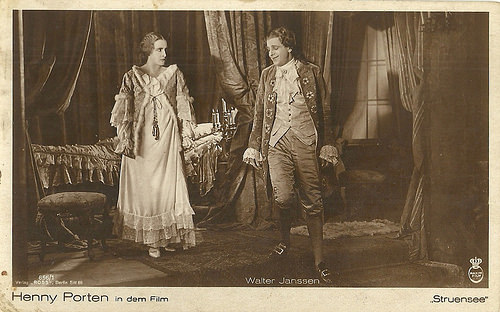
German postcard by Ross Verlag, no. 656/1. Photo: Maxim Film. Henny Porten and Walter Janssen in Struensee/Die Liebe einer Königin (Ludwig Wolff, 1923).
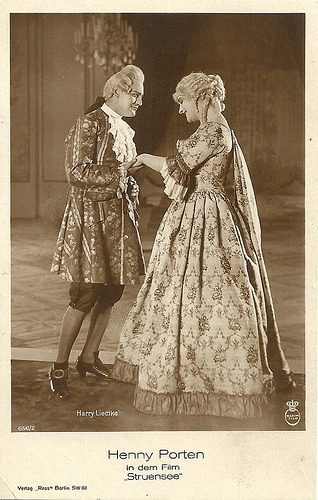
German postcard by Ross Verlag, no. 656/2. Photo: Maxim Film. Harry Liedtke and Henny Porten in Struensee/Die Liebe einer Königin (Ludwig Wolff, 1923).
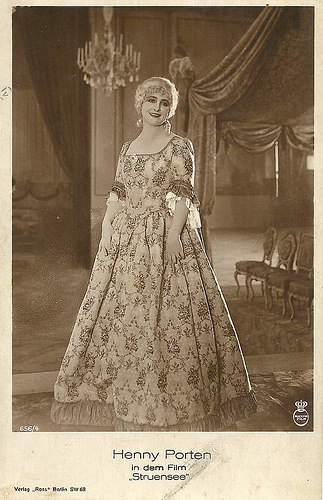
German postcard by Ross Verlag, no. 656/4. Photo: Maxim Film. Henny Porten in Struensee/Die Liebe einer Königin (Ludwig Wolff, 1923).
Forced pregnancy, homesickness and insanity
In 1766, 15-year-old Princess Caroline Mathilde ( Henny Porten ), youngest sister of King George III of England, is forced to marry her cousin, the notoriously insane King Christian VII of Denmark (Walter Janssen).
The Queen suffers from a forced pregnancy (she has a son with Christian), homesickness and the insanity of her husband. Gradually Caroline Mathilde falls in love with Johann Friedrich Struensee ( Harry Liedtke ), the smart new personal physician and counsellor of Christian.
She seduces him and gives herself the right to live her passion with the commoner. She even has an illegitimate daughter with him, Princess Louise Augusta, officially a daughter of Christian.
Struensee becomes de facto ruler of the kingdom and inspired by the Enlightenment he issues all kinds of reforms. Both are yet blind for the powers behind the screens. Christian VII at first tolerates the relationship of Caroline and Struensee, but acts when the enemy clique in court, led by the Queen-Dowager (Olga Limburg), accuses Struensee and the Queen of high treason.
Struensee is killed, while the queen's children are taken away from her and raised by her enemies. She herself is exiled to Castle Celle near Hannover, where, three years after, she dies of scarlet fever.
Struensee/Die Liebe einer Königin (1923) was written and directed by Ludwig Wolff and produced by Maxim Galitzenstein for his Maxim Film studio. Their film premiered in Berlin on 14 September 1923.
Several novels and stage plays were written about the Struensee affair. It was also at the heart of Per Olov Enquist's popular novel Livläkarens besök (The Visit of the Royal Physician, 1999). Irony has it that many a European royal house has lineage with Struensee through his daughter, Princess Louise Augusta.
There were several film adaptations of the historical affair. In 2012 it was again filmed as En kongelig affære/A Royal Affair by Nikolaj Arcel, starring Mads Mikkelsen as Struensee, Alicia Vikander as the Queen and Mikkel Følsgaard as the King. The film had nominations for both the Academy Award and the Golden Globe for Best Foreign Film. At the Berlin Film Festival, Mikkel Følsgaard won the Silver Bear for Best Actor.
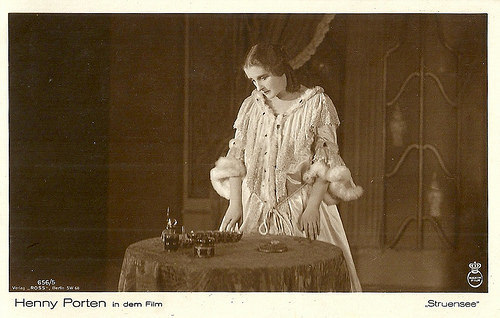
German postcard by Ross Verlag, no. 656/5. Photo: Maxim Film. Henny Porten in Struensee/Die Liebe einer Königin (Ludwig Wolff, 1923).
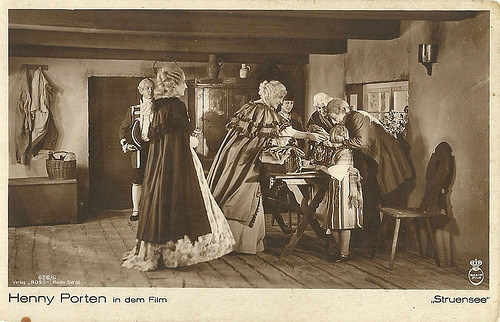
German postcard by Ross Verlag, no. 656/6. Photo: Maxim Film. Henny Porten in Struensee/Die Liebe einer Königin (Ludwig Wolff, 1923).
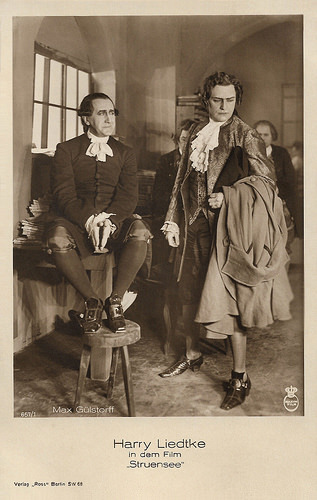
German postcard by Ross Verlag, no. 657/1. Photo: Maxim Film. Publicity still of Harry Liedtke and Max Gülstorff in Struensee/Die Liebe einer Königin (Ludwig Wolff, 1923).
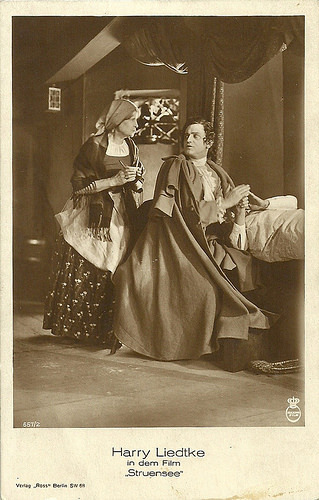
German postcard by Ross Verlag, no. 657/2. Photo: Maxim Film. Harry Liedtke in Struensee/Die Liebe einer Königin (Ludwig Wolff, 1923).
Sources: Wikipedia, Filmportal.de and IMDb.

German postcard by Ross Verlag, no. 656/1. Photo: Maxim Film. Henny Porten and Walter Janssen in Struensee/Die Liebe einer Königin (Ludwig Wolff, 1923).

German postcard by Ross Verlag, no. 656/2. Photo: Maxim Film. Harry Liedtke and Henny Porten in Struensee/Die Liebe einer Königin (Ludwig Wolff, 1923).

German postcard by Ross Verlag, no. 656/4. Photo: Maxim Film. Henny Porten in Struensee/Die Liebe einer Königin (Ludwig Wolff, 1923).
Forced pregnancy, homesickness and insanity
In 1766, 15-year-old Princess Caroline Mathilde ( Henny Porten ), youngest sister of King George III of England, is forced to marry her cousin, the notoriously insane King Christian VII of Denmark (Walter Janssen).
The Queen suffers from a forced pregnancy (she has a son with Christian), homesickness and the insanity of her husband. Gradually Caroline Mathilde falls in love with Johann Friedrich Struensee ( Harry Liedtke ), the smart new personal physician and counsellor of Christian.
She seduces him and gives herself the right to live her passion with the commoner. She even has an illegitimate daughter with him, Princess Louise Augusta, officially a daughter of Christian.
Struensee becomes de facto ruler of the kingdom and inspired by the Enlightenment he issues all kinds of reforms. Both are yet blind for the powers behind the screens. Christian VII at first tolerates the relationship of Caroline and Struensee, but acts when the enemy clique in court, led by the Queen-Dowager (Olga Limburg), accuses Struensee and the Queen of high treason.
Struensee is killed, while the queen's children are taken away from her and raised by her enemies. She herself is exiled to Castle Celle near Hannover, where, three years after, she dies of scarlet fever.
Struensee/Die Liebe einer Königin (1923) was written and directed by Ludwig Wolff and produced by Maxim Galitzenstein for his Maxim Film studio. Their film premiered in Berlin on 14 September 1923.
Several novels and stage plays were written about the Struensee affair. It was also at the heart of Per Olov Enquist's popular novel Livläkarens besök (The Visit of the Royal Physician, 1999). Irony has it that many a European royal house has lineage with Struensee through his daughter, Princess Louise Augusta.
There were several film adaptations of the historical affair. In 2012 it was again filmed as En kongelig affære/A Royal Affair by Nikolaj Arcel, starring Mads Mikkelsen as Struensee, Alicia Vikander as the Queen and Mikkel Følsgaard as the King. The film had nominations for both the Academy Award and the Golden Globe for Best Foreign Film. At the Berlin Film Festival, Mikkel Følsgaard won the Silver Bear for Best Actor.

German postcard by Ross Verlag, no. 656/5. Photo: Maxim Film. Henny Porten in Struensee/Die Liebe einer Königin (Ludwig Wolff, 1923).

German postcard by Ross Verlag, no. 656/6. Photo: Maxim Film. Henny Porten in Struensee/Die Liebe einer Königin (Ludwig Wolff, 1923).

German postcard by Ross Verlag, no. 657/1. Photo: Maxim Film. Publicity still of Harry Liedtke and Max Gülstorff in Struensee/Die Liebe einer Königin (Ludwig Wolff, 1923).

German postcard by Ross Verlag, no. 657/2. Photo: Maxim Film. Harry Liedtke in Struensee/Die Liebe einer Königin (Ludwig Wolff, 1923).
Sources: Wikipedia, Filmportal.de and IMDb.
Published on August 01, 2018 22:00
July 31, 2018
Louis Jouvet
Louis Jouvet (1887-1951) was one of the most influential personalities of the 20th century theatre. He is almost forgotten now, but Jouvet used to be a living glory of the French stage. He made a huge impact as both a stage director and an actor. His character, his eagle-like profile and his unique way of speaking made him also an unforgettable film star who appeared in some of the masterpieces of the ‘poetical realism’, the Golden Age of the French cinema.
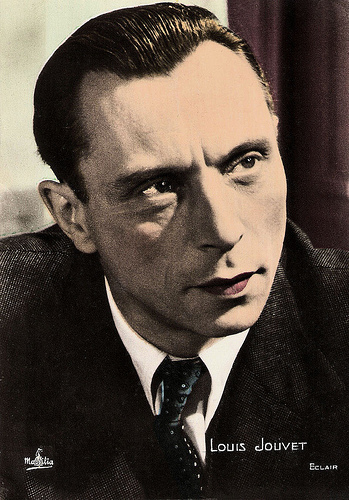
French postcard by Massilia. Photo: Eclair.
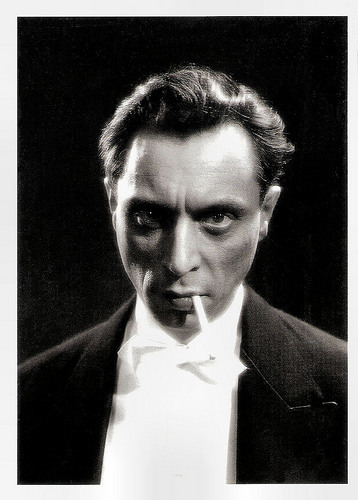
French postcard in the collection Magie Noire by Editions Hazan, Paris, 1990, no. 6218. Photo: publicity still for Les bas-fonds/Underground (Jean Renoir, 1936).
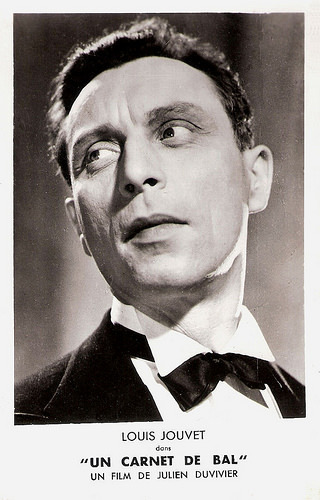
French postcard. Photo: publicity still for Un carnet de bal/Life Dances On (Julien Duvivier, 1937).
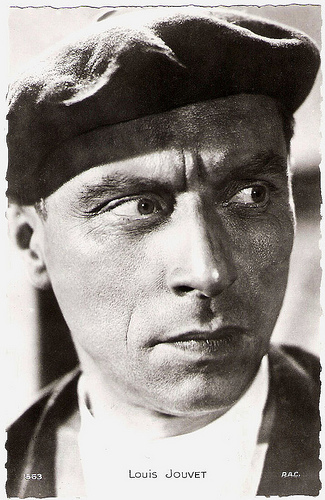
French postcard by Edit. Chantal, Rueil (S.-O.). Photo: R.A.C. Publicity still for Ramuntcho (René Barberis, 1938). Sent by mail in 1954.
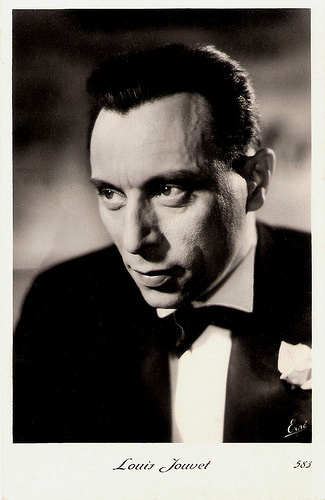
French postcard by Erpé, no. 583.
A staccato, syncopated diction
Jules Eugène Louis Jouvet was born in Crozon, Bretagne in 1887 in a devoutly catholic family. His father, from Brive, was an engineer, his mother Eugénie was from the Ardennes. When he was two years old, young Louis was sent to live with his grandmother Marie, in Belleville-sur-Bar in Ardennes, until 1894. Louis loved and admired his grandmother, and he would always remember this period as one of the happiest in his life.
At school, Louis was a quiet, reserved child spending his time working or dreaming. His teacher tried to make him lose his diction problems: he stammered and had great difficulty pronouncing the s. Later at the Notre-Dame College, where Chanoine Morigny was leading the theatre group with passion and harsh discipline, Louis became so preoccupied with his new passion for the theatre, that he decided to make it his career.
When Louis was 14, his father was crushed under rocks while he was overseeing the digging of a tunnel. After this tragedy, Louis left with his mother and two brothers to live with an uncle in Rethel in the Ardennes. Louis's uncle was a pharmacist, and his family urged him to make this his profession. From 1904, Louis studied pharmacy in Paris, but he spent all his spare time in the theatres.
His first job was as a pharmacy assistant, but he still longed to be an actor. Louis auditioned for the Conservatoire National Superieur d'Art Dramatique de Paris but he was rejected three times. He was reproached for his bad diction and his physical appearance. Jouvet was wounded by these failures, but managed to be admitted as auditor in Leloir's class at the Conservatoire in 1908. That's where he learned to better control his diction.
In 1908 Jouvet started to work for a theatre company as an administrator, later as a set dresser, and as an assistant. He approached actor Léon Noël after a performance and enrolled in his acting class, where he remained until 1910. Léon Noël was hard on his pupil, but Jouvet loved and respected him. In 1910 he finally made his stage debut in a production of The Brothers Karamazov. He also fell in love with a young Danish woman, Else Collin. In 1912 they married in Copenhagen and the couple would have three children, among them the later actress Lisa Jouvet.
In 1913, Jacques Copeau engaged him as a director for his Théâtre du Vieux-Colombier. This meant the turning point in his career. For a while, he was better known for his lighting design than for his acting (he even designed a new kind of lamp, named the jouvet). That year he also played a minor role in the film Shylock (Henri Desfontaines, 1913), starring Harry Baur, but his next film role would follow nearly two decades later.
Soon, critics and public alike took notice of Louis Jouvet's great acting talent in memorable productions of Molière's La Jalousie du Barbouillé, and William Shakespeare's Twelfth Night. He masked his speaking problems with a staccato, syncopated diction which made him instantly famous.
From 1919 till 1921 he worked in New York, appearing with his troupe in a repertory of productions that received much acclaim. In 1922, he broke with Jacques Copeau, and started his career as a stage director. He founded his own theatre company at the Théâtre des Champs-Élysées. There, he had his first great success with Knock ou le triomphe de la médecine (1923) by Jules Romains, which he played 1500 times.
In 1928, he met author Jean Giraudoux of whom he would go on to direct several plays. In 1934 he also became a teacher of acting technique and theatrical history at the Conservatoire de Paris. From 1935 on, he managed the Théâtre de l'Athénée in the centre of Paris, where the first performances took place of Giraudoux’ La guerre de Troie n'aura pas lieu (Tiger at the Gates) (1935), and Ondine (1939).
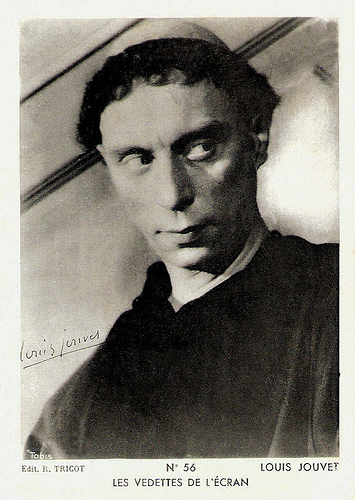
French collectors card in the series Les Vedettes de L'écran by Edit. R. Tricot, offered by Becco Douceurs, no. 56. Photo: Tobis. Publicity still for La Kermesse héroïque/Carnival in Flanders (Jacques Feyder, 1935).
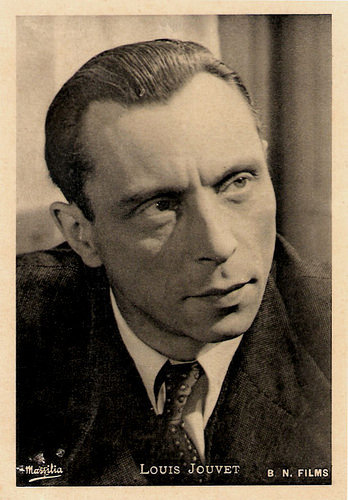
French card by Massilia. Photo: B.N. Films. Publicity still for L'Alibi /The Alibi (Pierre Chenal, 1937).
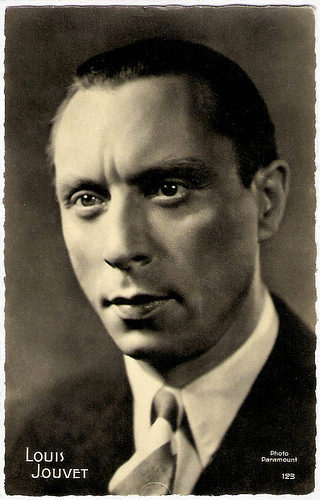
French postcard by Editions O.P., Paris, no. 123. Photo: Paramount.
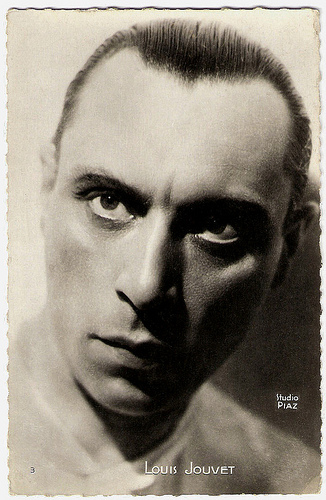
French postcard by Editions P.I., Paris, no. 3. Photo: Studio Piaz.
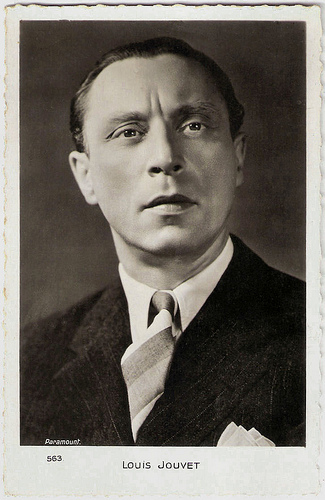
French postcard by Collection Chantal, Paris, no. 563. Photo: Paramount.
Undisputed classics
Louis Jouvet would dedicate his life to the theatre. He is reputed to have said that he acted in films only so that he could raise the money to finance his stage work. Yet his 32 films, many of which are now undisputed classics of the French cinema, provide an enduring record of the talent of this great actor.
Jouvet made his first significant film appearance in the comedy Topaze (Louis Gasnier, 1932), an adaptation of a play written by Marcel Pagnol, whom Jouvet admired greatly. He played an earnest schoolteacher who teaches his pupils that honesty is the best policy eventually changes his mind when confronted with the corruption of the business world. The film was made at the Joinville Studios in Paris by the French subsidiary of Paramount Pictures.
The following year, Jouvet enjoyed his first commercial film success with the adaptation of his stage hit Knock ou le triomphe de la médecine/Knock (Louis Jouvet, Roger Goupillières, 1933). In Knock, he cast a young actress in a small role, Madeleine Ozeray . They would remain together for the next ten years, both on stage and in life.
Soon more film successes followed, such as the historical romantic comedy La kermesse héroïque/Carnival in Flanders (Jacques Feyder, 1935) with Françoise Rosay , and the drama Un Carnet de bal/Life Dances On (Julien Duvivier, 1937) starring Marie Bell , but his subtle, forceful, witty performances redeemed also some poor films.
His finest performances were in some of the masterpieces of the poetic realism cinema: the black comic farce Drôle de drame/Bizarre, Bizarre (Marcel Carné, 1936) in which he played the Bishop of Bedford opposite Michel Simon , the drama Hotel du Nord (Marcel Carné, 1938) with Annabella and Arletty , and the drama La fin du jour/The End of a Day (Julien Duvivier, 1939) with Jean Gabin .
Jouvet also appeared in two films by Jean Renoir. In the romantic crime drama Les bas-fonds/The Lower Depths (1936) he played a bankrupt baron who makes friends with a charismatic thief (Jean Gabin) and comes to live in the thief's slum. La Marseillaise/The Marseillaise (1938) is a news-reel like film about early part of the French Revolution, shown from the eyes of individual people, including Jouvet as a district attorney.
In 1941, having experienced serious problems with the censorship of the German occupier, he took his repertory company for a tour of South America. Only after the war, Jouvet returned to France. Again as the director of the théâtre de l’Athénée, he created with Giraudoux La Folle de Chaillot (The Madwoman of Chaillot) (1945). He also helped the new theatre figures like André Barsacq, Jean-Louis Barrault and Jean Vilar.
His comeback film after the war was the atmospheric thriller Quai des Orfèvres/Quay of the Goldsmiths (Henri-Georges Clouzot, 1947) with Suzy Delair . Jouvet had become good friends with director Clouzot before World War II. Jouvet accepted the part of Inspector Antoine on the condition that a flexible shooting schedule would be allowed and that Clouzot would cast some of Jouvet's troupe members in the film, including Charles Dullin as Brignon, the murder victim. In 1947, Quai des Orfèvres was the fourth most popular film in France, drawing 5.5 million spectators.
In 1950, Louis Jouvet received the Légion d'honneur. Just before his death he appeared in a new film adaptation of his old success, Knock ou le triomphe de la médecine: Knock/Dr. Knock (Guy Lefranc, 1951). It also featured Jean Brochard, Pierre Renoir , Jean Carmet and an uncredited appearance by Louis de Funès .
At the age of 63, Louis Jouvet died of a heart attack in 1951 in Paris. He was buried in the Montmartre Cemetery. Jouvet was married twice; to Else Collin and to Madeleine Ozeray . The Athénée theatre now includes his name as an homage: Athénée Théâtre Louis-Jouvet.
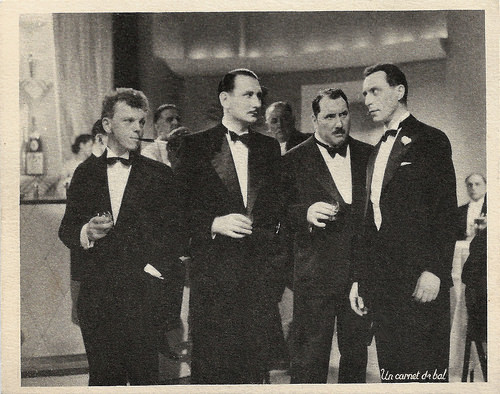
French collectors card by Dist. Les Films Vog. Photo: publicity still for Un carnet de bal/Dance Program (Julien Duvivier, 1937) with Louis Jouvet at right.
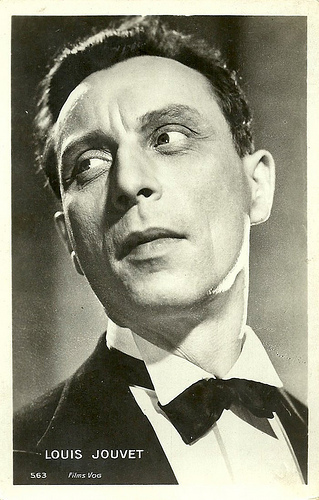
French postcard by Editions Chantal, Paris, no. 563. Photo: Dist. Les Films Vog. Publicity still for Un carnet de bal (Julien Duvivier, 1937).
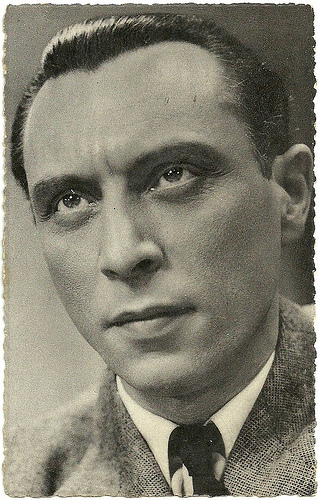
Belgian postcard, offered by Kwatta chocolade. Photo: Dist. Filmsonor / N. Els, Bromurite.
Scene from Drôle de drame/Bizarre, Bizarre (1936) with Jouvet and Michel Simon . Source: Julien Morvan (YouTube). Sorry, no subtitles.
French trailer for La fin du jour/The End of a Day (Julien Duvivier, 1939). Source: Pathe (YouTube). Sorry, no subtitles.
Sources: James Travers (Films de France), (IMDb), Geocities, AllMovie, Wikipedia, and .

French postcard by Massilia. Photo: Eclair.

French postcard in the collection Magie Noire by Editions Hazan, Paris, 1990, no. 6218. Photo: publicity still for Les bas-fonds/Underground (Jean Renoir, 1936).

French postcard. Photo: publicity still for Un carnet de bal/Life Dances On (Julien Duvivier, 1937).

French postcard by Edit. Chantal, Rueil (S.-O.). Photo: R.A.C. Publicity still for Ramuntcho (René Barberis, 1938). Sent by mail in 1954.

French postcard by Erpé, no. 583.
A staccato, syncopated diction
Jules Eugène Louis Jouvet was born in Crozon, Bretagne in 1887 in a devoutly catholic family. His father, from Brive, was an engineer, his mother Eugénie was from the Ardennes. When he was two years old, young Louis was sent to live with his grandmother Marie, in Belleville-sur-Bar in Ardennes, until 1894. Louis loved and admired his grandmother, and he would always remember this period as one of the happiest in his life.
At school, Louis was a quiet, reserved child spending his time working or dreaming. His teacher tried to make him lose his diction problems: he stammered and had great difficulty pronouncing the s. Later at the Notre-Dame College, where Chanoine Morigny was leading the theatre group with passion and harsh discipline, Louis became so preoccupied with his new passion for the theatre, that he decided to make it his career.
When Louis was 14, his father was crushed under rocks while he was overseeing the digging of a tunnel. After this tragedy, Louis left with his mother and two brothers to live with an uncle in Rethel in the Ardennes. Louis's uncle was a pharmacist, and his family urged him to make this his profession. From 1904, Louis studied pharmacy in Paris, but he spent all his spare time in the theatres.
His first job was as a pharmacy assistant, but he still longed to be an actor. Louis auditioned for the Conservatoire National Superieur d'Art Dramatique de Paris but he was rejected three times. He was reproached for his bad diction and his physical appearance. Jouvet was wounded by these failures, but managed to be admitted as auditor in Leloir's class at the Conservatoire in 1908. That's where he learned to better control his diction.
In 1908 Jouvet started to work for a theatre company as an administrator, later as a set dresser, and as an assistant. He approached actor Léon Noël after a performance and enrolled in his acting class, where he remained until 1910. Léon Noël was hard on his pupil, but Jouvet loved and respected him. In 1910 he finally made his stage debut in a production of The Brothers Karamazov. He also fell in love with a young Danish woman, Else Collin. In 1912 they married in Copenhagen and the couple would have three children, among them the later actress Lisa Jouvet.
In 1913, Jacques Copeau engaged him as a director for his Théâtre du Vieux-Colombier. This meant the turning point in his career. For a while, he was better known for his lighting design than for his acting (he even designed a new kind of lamp, named the jouvet). That year he also played a minor role in the film Shylock (Henri Desfontaines, 1913), starring Harry Baur, but his next film role would follow nearly two decades later.
Soon, critics and public alike took notice of Louis Jouvet's great acting talent in memorable productions of Molière's La Jalousie du Barbouillé, and William Shakespeare's Twelfth Night. He masked his speaking problems with a staccato, syncopated diction which made him instantly famous.
From 1919 till 1921 he worked in New York, appearing with his troupe in a repertory of productions that received much acclaim. In 1922, he broke with Jacques Copeau, and started his career as a stage director. He founded his own theatre company at the Théâtre des Champs-Élysées. There, he had his first great success with Knock ou le triomphe de la médecine (1923) by Jules Romains, which he played 1500 times.
In 1928, he met author Jean Giraudoux of whom he would go on to direct several plays. In 1934 he also became a teacher of acting technique and theatrical history at the Conservatoire de Paris. From 1935 on, he managed the Théâtre de l'Athénée in the centre of Paris, where the first performances took place of Giraudoux’ La guerre de Troie n'aura pas lieu (Tiger at the Gates) (1935), and Ondine (1939).

French collectors card in the series Les Vedettes de L'écran by Edit. R. Tricot, offered by Becco Douceurs, no. 56. Photo: Tobis. Publicity still for La Kermesse héroïque/Carnival in Flanders (Jacques Feyder, 1935).

French card by Massilia. Photo: B.N. Films. Publicity still for L'Alibi /The Alibi (Pierre Chenal, 1937).

French postcard by Editions O.P., Paris, no. 123. Photo: Paramount.

French postcard by Editions P.I., Paris, no. 3. Photo: Studio Piaz.

French postcard by Collection Chantal, Paris, no. 563. Photo: Paramount.
Undisputed classics
Louis Jouvet would dedicate his life to the theatre. He is reputed to have said that he acted in films only so that he could raise the money to finance his stage work. Yet his 32 films, many of which are now undisputed classics of the French cinema, provide an enduring record of the talent of this great actor.
Jouvet made his first significant film appearance in the comedy Topaze (Louis Gasnier, 1932), an adaptation of a play written by Marcel Pagnol, whom Jouvet admired greatly. He played an earnest schoolteacher who teaches his pupils that honesty is the best policy eventually changes his mind when confronted with the corruption of the business world. The film was made at the Joinville Studios in Paris by the French subsidiary of Paramount Pictures.
The following year, Jouvet enjoyed his first commercial film success with the adaptation of his stage hit Knock ou le triomphe de la médecine/Knock (Louis Jouvet, Roger Goupillières, 1933). In Knock, he cast a young actress in a small role, Madeleine Ozeray . They would remain together for the next ten years, both on stage and in life.
Soon more film successes followed, such as the historical romantic comedy La kermesse héroïque/Carnival in Flanders (Jacques Feyder, 1935) with Françoise Rosay , and the drama Un Carnet de bal/Life Dances On (Julien Duvivier, 1937) starring Marie Bell , but his subtle, forceful, witty performances redeemed also some poor films.
His finest performances were in some of the masterpieces of the poetic realism cinema: the black comic farce Drôle de drame/Bizarre, Bizarre (Marcel Carné, 1936) in which he played the Bishop of Bedford opposite Michel Simon , the drama Hotel du Nord (Marcel Carné, 1938) with Annabella and Arletty , and the drama La fin du jour/The End of a Day (Julien Duvivier, 1939) with Jean Gabin .
Jouvet also appeared in two films by Jean Renoir. In the romantic crime drama Les bas-fonds/The Lower Depths (1936) he played a bankrupt baron who makes friends with a charismatic thief (Jean Gabin) and comes to live in the thief's slum. La Marseillaise/The Marseillaise (1938) is a news-reel like film about early part of the French Revolution, shown from the eyes of individual people, including Jouvet as a district attorney.
In 1941, having experienced serious problems with the censorship of the German occupier, he took his repertory company for a tour of South America. Only after the war, Jouvet returned to France. Again as the director of the théâtre de l’Athénée, he created with Giraudoux La Folle de Chaillot (The Madwoman of Chaillot) (1945). He also helped the new theatre figures like André Barsacq, Jean-Louis Barrault and Jean Vilar.
His comeback film after the war was the atmospheric thriller Quai des Orfèvres/Quay of the Goldsmiths (Henri-Georges Clouzot, 1947) with Suzy Delair . Jouvet had become good friends with director Clouzot before World War II. Jouvet accepted the part of Inspector Antoine on the condition that a flexible shooting schedule would be allowed and that Clouzot would cast some of Jouvet's troupe members in the film, including Charles Dullin as Brignon, the murder victim. In 1947, Quai des Orfèvres was the fourth most popular film in France, drawing 5.5 million spectators.
In 1950, Louis Jouvet received the Légion d'honneur. Just before his death he appeared in a new film adaptation of his old success, Knock ou le triomphe de la médecine: Knock/Dr. Knock (Guy Lefranc, 1951). It also featured Jean Brochard, Pierre Renoir , Jean Carmet and an uncredited appearance by Louis de Funès .
At the age of 63, Louis Jouvet died of a heart attack in 1951 in Paris. He was buried in the Montmartre Cemetery. Jouvet was married twice; to Else Collin and to Madeleine Ozeray . The Athénée theatre now includes his name as an homage: Athénée Théâtre Louis-Jouvet.

French collectors card by Dist. Les Films Vog. Photo: publicity still for Un carnet de bal/Dance Program (Julien Duvivier, 1937) with Louis Jouvet at right.

French postcard by Editions Chantal, Paris, no. 563. Photo: Dist. Les Films Vog. Publicity still for Un carnet de bal (Julien Duvivier, 1937).

Belgian postcard, offered by Kwatta chocolade. Photo: Dist. Filmsonor / N. Els, Bromurite.
Scene from Drôle de drame/Bizarre, Bizarre (1936) with Jouvet and Michel Simon . Source: Julien Morvan (YouTube). Sorry, no subtitles.
French trailer for La fin du jour/The End of a Day (Julien Duvivier, 1939). Source: Pathe (YouTube). Sorry, no subtitles.
Sources: James Travers (Films de France), (IMDb), Geocities, AllMovie, Wikipedia, and .
Published on July 31, 2018 22:00
July 30, 2018
New Amit Benyovits acquisition: Clovis Star Chocolate Cards
In 2012, collector Amit Benyovits started our love for Massilia collectors cards. Last week he sent me scans of a new acquisition, a series of 50 'Premium' collectors cards from Belgium. The cards were produced for Chocolaterie Clovis in Pepinster, and while Belgium is a bilingual country, the texts on the flip sides of the cards are both in French (the language spoken in Wallonia) and in Dutch (spoken in Flanders). The cards were printed in Italy by Bromofoto in Milan, and the portrayed stars are all well known Hollywood movie actors. There are no dates on the cards, but Amit and I guess they were made in the late 1940s.
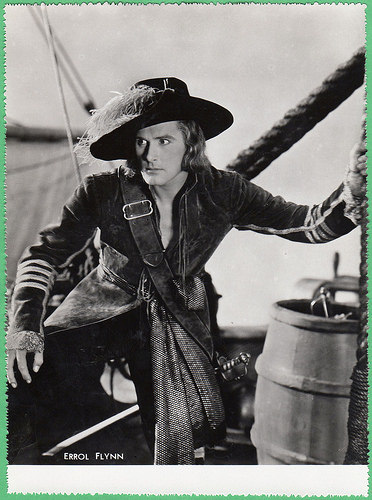
Errol Flynn . Belgian collectors card by Chocolaterie Clovis, Pepinster. Photo: publicity still for Captain Blood (Michael Curtiz, 1935). Collection: Amit Benyovits.
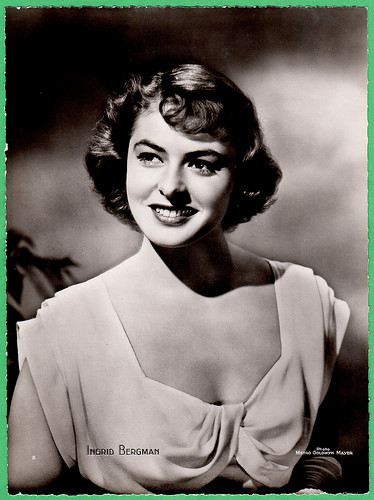
Ingrid Bergman . Belgian collectors card by Chocolaterie Clovis, Pepinster, no. 5. Photo: Metro Goldwyn Mayer. Collection: Amit Benyovits.
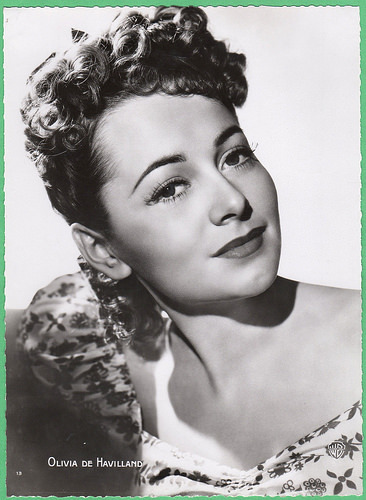
Olivia de Havilland. Belgian collectors card by Chocolaterie Clovis, Pepinster, no. 13. Photo: Warner Brothers. Collection: Amit Benyovits.
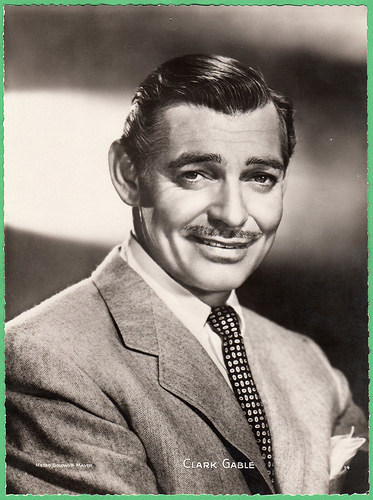
Clark Gable. Belgian collectors card by Chocolaterie Clovis, Pepinster, no. 14. Photo: Metro-Goldwyn-Mayer. Collection: Amit Benyovits.

Myrna Loy. Belgian collectors card by Chocolaterie Clovis, Pepinster, no. 25. Photo: Universal International. Collection: Amit Benyovits.
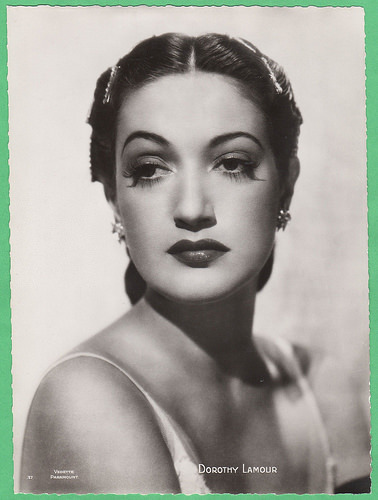
Dorothy Lamour. Belgian collectors card by Chocolaterie Clovis, Pepinster, no. 37. Photo: Paramount. Collection: Amit Benyovits.
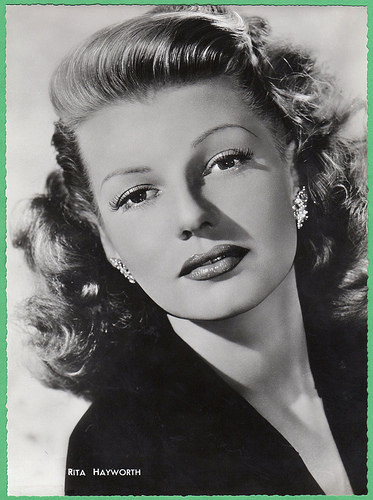
Rita Hayworth . Belgian collectors card by Chocolaterie Clovis, Pepinster. Collection: Amit Benyovits
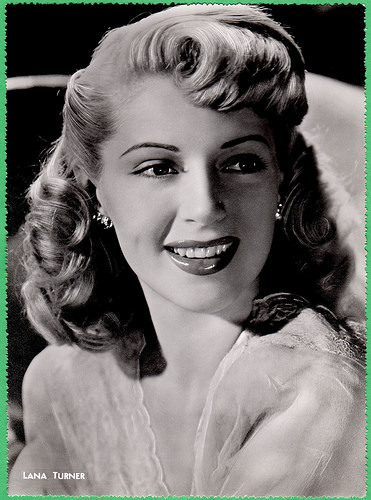
Lana Turner. Belgian collectors card by Chocolaterie Clovis, Pepinster. Collection: Amit Benyovits.
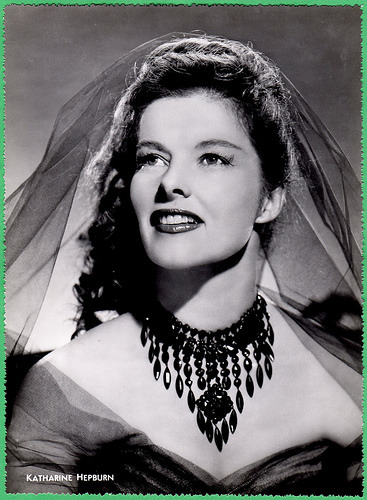
Katharine Hepburn. Belgian collectors card by Chocolaterie Clovis, Pepinster. Collection: Amit Benyovits.
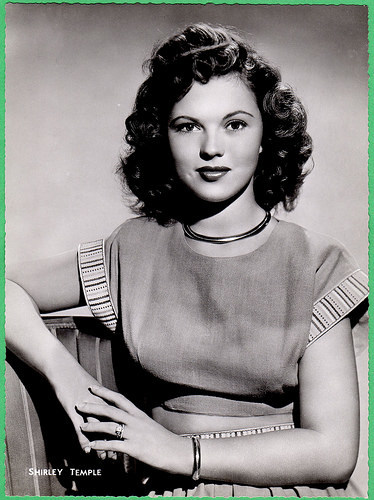
Shirley Temple. Belgian collectors card by Chocolaterie Clovis, Pepinster. Collection: Amit Benyovits.
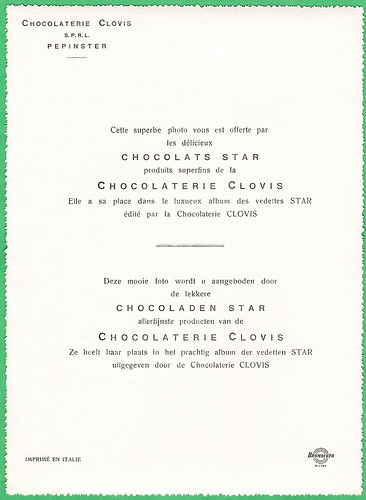
Flipside of Belgian collectors card by Chocolaterie Clovis, Pepinster. Collection: Amit Benyovits.
Show me your chocolate side, please
Belgium must be the no. 1 Chocolate country in the world. There are many little chocolate factories and their 'pralines' are delicious. The Belgians, but also foreign visitors, go to shop for them on Sundays in the countless confiseries of the country.
I had never heard of Chocolaterie Clovis before. French Wikipedia writes that the factory does not exist anymore. Clovis was founded in 1920 in Pepinster. The company ceased operations in 1966, following the destruction of the buildings by fire.
In the 1930s and 1940s, there must have been a close connection between chocolate and film stars. Directors prepared their female stars for their close-ups by saying: "Show me your chocolate side, please", as commemorated by Dutch film star Cissy van Bennekom in an old interview with Vrij Nederland magazine.
Other Belgian chocolate firms, like Kwatta , also published film star postcards and included them with their products. So, this beautiful series of film star cards is one of the few things that still remind us of Chocolaterie Clovis. A sweet reminder.
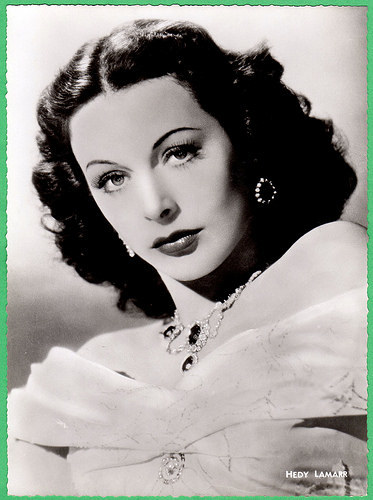
Hedy Lamarr . Belgian collectors card by Chocolaterie Clovis, Pepinster. Photo: Paramount. Collection: Amit Benyovits.
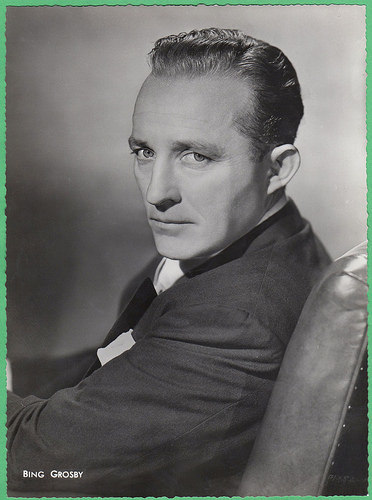
Bing Crosby. Belgian collectors card by Chocolaterie Clovis, Pepinster. Collection: Amit Benyovits.
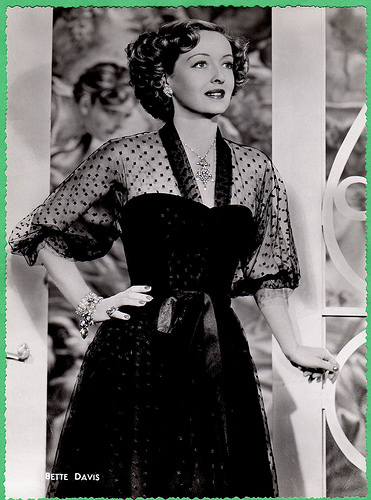
Bette Davis. Belgian collectors card by Chocolaterie Clovis, Pepinster. Collection: Amit Benyovits.
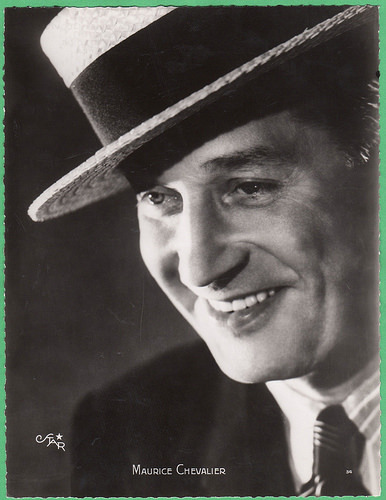
Maurice Chevalier . Belgian collectors card by Chocolaterie Clovis, Pepinster, no. 34. Photo: Star. Collection: Amit Benyovits.
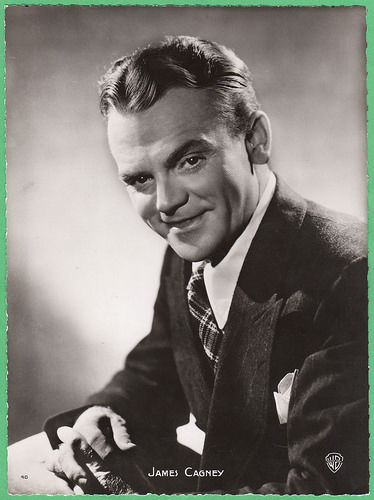
James Cagney. Belgian collectors card by Chocolaterie Clovis, Pepinster, no. 40. Photo: Warner Bros. Collection: Amit Benyovits.
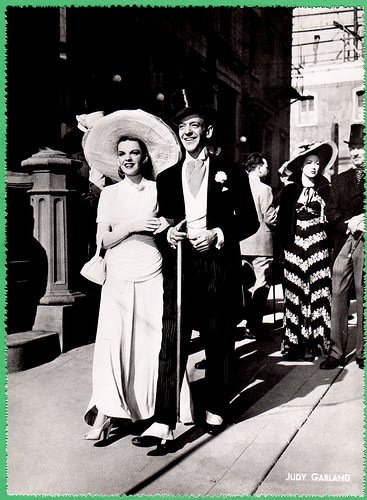
Judy Garland and Fred Astaire. Belgian collectors card by Chocolaterie Clovis, Pepinster. Photo: Metro Goldwyn Mayer. Publicity still for Easter Parade (Charles Walters, 1948). Collection: Amit Benyovits.
High grade and well made
The 50 Clovis photos came housed in a special album. Amit Benyovits sent me some pictures of the high grade and well made album, which you can see below. Amit: "The card stock is very thick and of very high quality pictures and paper."
In his mails to me, Amit also mentioned that the album size is 10 x 11 3/4" (25 x 30 cm) and the card size 6 1/2 x 8 7/8" (16,5 x 22,5 cm). Among the 50 cards there are at least 8 different backs but all with Clovis Pepinster either stamped or pre-printed on the backs. Sometimes the cards have the backs showing they were produced by a well known postcard publisher in Italy, Bromofoto in Milano (Milan).
Amit: "I'm dating these in the 1940s as some stars only began their careers during that time. It is mine and Cliff Aliperti's as well as Troy Kirk's opinion that these are what we call in North America 'Premium' photos. Premium photos are those that are acquired from the company. By redemption of something you had to mail in ...in Clovis' case probably a certain number of Clovis cards plus some cash too. We are just speculating and hope that you may be able to shed some light on how these were acquired by collectors."
My guess is that the cards were not sold, but were included as gifts in the Clovis Star chocolate boxes. Customers got probably hooked and must have lost their nice figures while collecting all these beautiful star cards.
The albums could be bought in the chocolate shops. Anyway that was - and still is - one of the traditions of collecting cards in the Netherlands. Another form of collecting is buying packages of cards in tobacco shops, like the famous Panini cards of soccer players and pop stars.
Clovis also made other series of collectors cards, for example a series with cyclists. Then and now, cycling is a very popular sports in Belgium.
I like Amit's Clovis star cards very much and only had two Clovis cards in my own collection. So Amit, thank you very much for sharing this new acquisition with us!
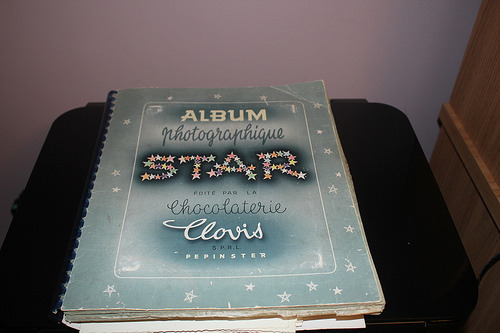
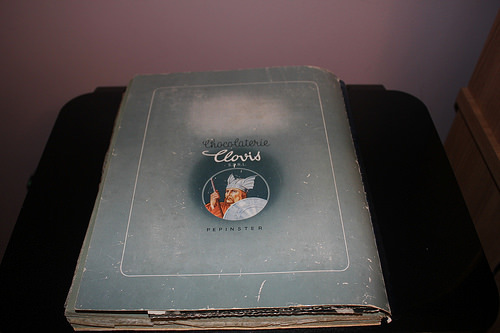
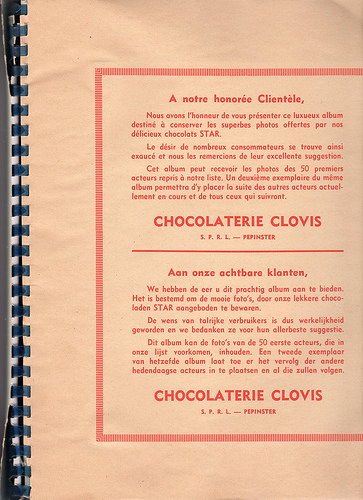
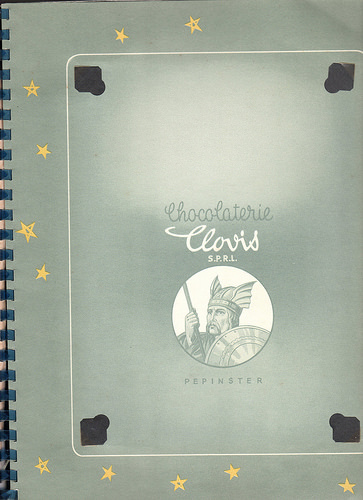
Album for Belgian Star collectors cards by Chocolaterie Clovis, Pepinster. Collection: Amit Benyovits.
Sources: Amit Benyovits and Wikipedia (French).

Errol Flynn . Belgian collectors card by Chocolaterie Clovis, Pepinster. Photo: publicity still for Captain Blood (Michael Curtiz, 1935). Collection: Amit Benyovits.

Ingrid Bergman . Belgian collectors card by Chocolaterie Clovis, Pepinster, no. 5. Photo: Metro Goldwyn Mayer. Collection: Amit Benyovits.

Olivia de Havilland. Belgian collectors card by Chocolaterie Clovis, Pepinster, no. 13. Photo: Warner Brothers. Collection: Amit Benyovits.

Clark Gable. Belgian collectors card by Chocolaterie Clovis, Pepinster, no. 14. Photo: Metro-Goldwyn-Mayer. Collection: Amit Benyovits.

Myrna Loy. Belgian collectors card by Chocolaterie Clovis, Pepinster, no. 25. Photo: Universal International. Collection: Amit Benyovits.

Dorothy Lamour. Belgian collectors card by Chocolaterie Clovis, Pepinster, no. 37. Photo: Paramount. Collection: Amit Benyovits.

Rita Hayworth . Belgian collectors card by Chocolaterie Clovis, Pepinster. Collection: Amit Benyovits

Lana Turner. Belgian collectors card by Chocolaterie Clovis, Pepinster. Collection: Amit Benyovits.

Katharine Hepburn. Belgian collectors card by Chocolaterie Clovis, Pepinster. Collection: Amit Benyovits.

Shirley Temple. Belgian collectors card by Chocolaterie Clovis, Pepinster. Collection: Amit Benyovits.

Flipside of Belgian collectors card by Chocolaterie Clovis, Pepinster. Collection: Amit Benyovits.
Show me your chocolate side, please
Belgium must be the no. 1 Chocolate country in the world. There are many little chocolate factories and their 'pralines' are delicious. The Belgians, but also foreign visitors, go to shop for them on Sundays in the countless confiseries of the country.
I had never heard of Chocolaterie Clovis before. French Wikipedia writes that the factory does not exist anymore. Clovis was founded in 1920 in Pepinster. The company ceased operations in 1966, following the destruction of the buildings by fire.
In the 1930s and 1940s, there must have been a close connection between chocolate and film stars. Directors prepared their female stars for their close-ups by saying: "Show me your chocolate side, please", as commemorated by Dutch film star Cissy van Bennekom in an old interview with Vrij Nederland magazine.
Other Belgian chocolate firms, like Kwatta , also published film star postcards and included them with their products. So, this beautiful series of film star cards is one of the few things that still remind us of Chocolaterie Clovis. A sweet reminder.

Hedy Lamarr . Belgian collectors card by Chocolaterie Clovis, Pepinster. Photo: Paramount. Collection: Amit Benyovits.

Bing Crosby. Belgian collectors card by Chocolaterie Clovis, Pepinster. Collection: Amit Benyovits.

Bette Davis. Belgian collectors card by Chocolaterie Clovis, Pepinster. Collection: Amit Benyovits.

Maurice Chevalier . Belgian collectors card by Chocolaterie Clovis, Pepinster, no. 34. Photo: Star. Collection: Amit Benyovits.

James Cagney. Belgian collectors card by Chocolaterie Clovis, Pepinster, no. 40. Photo: Warner Bros. Collection: Amit Benyovits.

Judy Garland and Fred Astaire. Belgian collectors card by Chocolaterie Clovis, Pepinster. Photo: Metro Goldwyn Mayer. Publicity still for Easter Parade (Charles Walters, 1948). Collection: Amit Benyovits.
High grade and well made
The 50 Clovis photos came housed in a special album. Amit Benyovits sent me some pictures of the high grade and well made album, which you can see below. Amit: "The card stock is very thick and of very high quality pictures and paper."
In his mails to me, Amit also mentioned that the album size is 10 x 11 3/4" (25 x 30 cm) and the card size 6 1/2 x 8 7/8" (16,5 x 22,5 cm). Among the 50 cards there are at least 8 different backs but all with Clovis Pepinster either stamped or pre-printed on the backs. Sometimes the cards have the backs showing they were produced by a well known postcard publisher in Italy, Bromofoto in Milano (Milan).
Amit: "I'm dating these in the 1940s as some stars only began their careers during that time. It is mine and Cliff Aliperti's as well as Troy Kirk's opinion that these are what we call in North America 'Premium' photos. Premium photos are those that are acquired from the company. By redemption of something you had to mail in ...in Clovis' case probably a certain number of Clovis cards plus some cash too. We are just speculating and hope that you may be able to shed some light on how these were acquired by collectors."
My guess is that the cards were not sold, but were included as gifts in the Clovis Star chocolate boxes. Customers got probably hooked and must have lost their nice figures while collecting all these beautiful star cards.
The albums could be bought in the chocolate shops. Anyway that was - and still is - one of the traditions of collecting cards in the Netherlands. Another form of collecting is buying packages of cards in tobacco shops, like the famous Panini cards of soccer players and pop stars.
Clovis also made other series of collectors cards, for example a series with cyclists. Then and now, cycling is a very popular sports in Belgium.
I like Amit's Clovis star cards very much and only had two Clovis cards in my own collection. So Amit, thank you very much for sharing this new acquisition with us!




Album for Belgian Star collectors cards by Chocolaterie Clovis, Pepinster. Collection: Amit Benyovits.
Sources: Amit Benyovits and Wikipedia (French).
Published on July 30, 2018 22:00
Paul van Yperen's Blog
- Paul van Yperen's profile
- 13 followers
Paul van Yperen isn't a Goodreads Author
(yet),
but they
do have a blog,
so here are some recent posts imported from
their feed.



